Mark Dunphy
Irish Weather Online
Sat, 01 Oct 2011 08:17 CDT
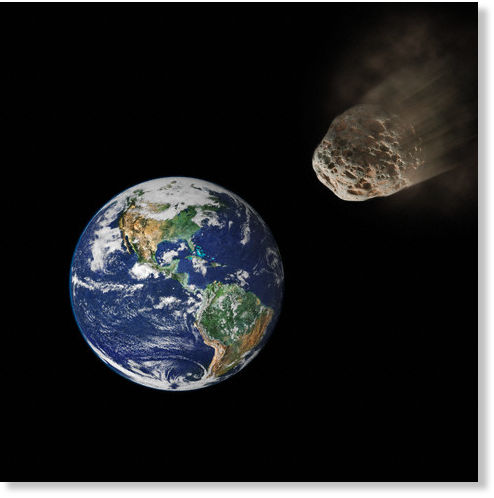
© Unknown
A 1300-foot-wide (400 metres) asteroid, which is more than one and a half times the length of a soccer pitch, will pass within 0.85 lunar distances of the Earth on November 8/9, 2011.
Discovered on December 28, 2005 by Robert McMillan of the Spacewatch Program near Tucson, Arizona, 2005 YU55 is believed to be a very dark, nearly spherical object.
According to NASA's Near Earth Object Program: "Although classified as a potentially hazardous object, 2005 YU55 poses no threat of an Earth collision over at least the next 100 years. However, this will be the closest approach to date by an object this large that we know about in advance and an event of this type will not happen again until 2028 when asteroid (153814) 2001 WN5 will pass to within 0.6 lunar distances."
Click here to watch the trajectory of Asteroid 2005 YU55 - November 8-9, 2011.
While neither the European Space Agency (ESA) nor NASA has suggested that YU55 poses a threat to Earth, plans to develop a mission to counteract a potential asteroid collision in the future are already underway.
The ESA is planning to fire an 'impactor' satellite into a 'test' asteroid in 2015 to see if the object's trajectory can be altered. The Agency is conducting the test mission in light of the minimal threat posed by the 700-1100-foot-wide 99942 Apophis asteroid, which has a one in 250,000 chance of impacting Earth in 2036.
Other Recent Asteroid Encounters
In late June 2011, earth experienced one of its closest encounters with an asteroid in recent years. But as NASA indicated in the days ahead of the 'cosmic close call', the encounter was so close that Earth's gravity sharply altered the asteroid's trajectory and prevented the space rock from impacting the planet.
2011MD, a newly discovered asteroid passed within 12,000 kilometres (7,500 miles) of Earth. The asteroid was only sighted for the first time on 22 June by a robotic telescope in New Mexico, USA. The International Astronomical Union's Minor Planet Center in Massachusetts, USA, put out an alert Thursday.
It was daylight in the UK and Ireland (12.30 GMT) when the asteroid passed over the southern Atlantic Ocean, near the coast of Antarctica. The event was observable from South Africa and parts of Antarctica. It also was visible in the hours leading up to the closest approach across Australia, New Zealand, southern and eastern Asia, and the western Pacific.
Some media outlets proclaimed the asteroid to be as big as New York's Empire State Building'. In fact, 2011 MD measured about 16 feet to 35 feet.
According to Minor Planet Center's ranking charts 2011 MD's trip was the fifth-closest recorded Asteroid event. The last asteroid to impact earth was '2008 TC3' which was detected on 7 October 2008, just 19 hours before it burned up in the atmosphere over northern Sudan.
On 2 June, a 10-metre wide asteroid passed between the earth and moon.
Asteroid 2009 BD, which was first observed on 16 January 2009 passed approximately within 0.9 lunar distances (the distance between Earth and the Moon) of earth. Astronomers believe the rock is a rare "co-orbital asteroid" which follows the orbit of the Earth, not receding more than 0.1 AU (15 million km) away.
Two asteroids, several meters in diameter and in unrelated orbits, passed within the moon's distance of Earth on September 8 2010. In April 2010 an asteroid roughly as long as a tennis court zoomed past Earth at about the distance of the moon. The space rock to pass at or within lunar distance previous to this was 2009 JL2, an asteroid about 17 to 37 metres across, in May 2009.
There is a roughly 50 percent chance of a 30-metre-wide plus asteroid striking Earth each century, according to Clark Chapman, a space scientist at the Southwest Research Institute in Boulder, Colorado, USA.
NASA Asteroid Research
Earlier this week, NASA announced it has discovered more than 90 percent of the largest near-Earth asteroids, meeting a goal agreed to with the United States Congress in 1998. The Agency also believes that all near-Earth asteroids approximately 6 miles (10 kilometres) across, as big as the one thought to have wiped out the dinosaurs, have been found.
New observations by NASA's Wide-field Infrared Survey Explorer, or WISE, indicate have allowed astronomers now estimate there are roughly 19,500 - not 35,000 - mid-size near-Earth asteroids. Scientists say this improved understanding of the population may indicate the hazard to Earth could be somewhat less than previously thought.
However, the majority of these mid-size asteroids remain to be discovered. More research also is needed to determine if fewer mid-size objects (between 330 and 3,300-feet wide) also mean fewer potentially hazardous asteroids, those that come closest to Earth.
The results come from the most accurate census to date of near-Earth asteroids, the space rocks that orbit within 120 million miles (195 million kilometres) of the sun into Earth's orbital vicinity.
WISE scanned the entire celestial sky twice in infrared light between January 2010 and February 2011, continuously snapping pictures of everything from distant galaxies to near-Earth asteroids and comets. NEOWISE observed more than 100 thousand asteroids in the main belt between Mars and Jupiter, in addition to at least 585 near Earth.
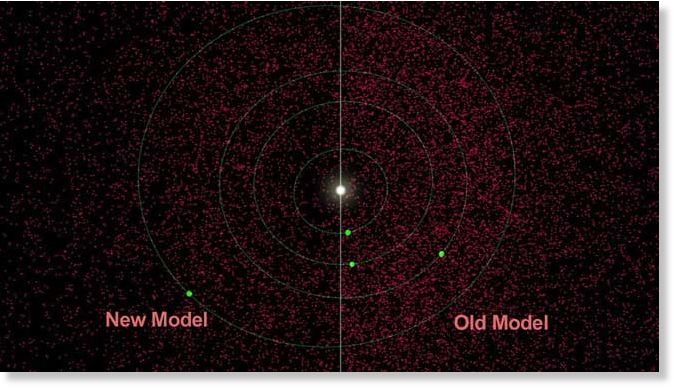
© NASA/JPL-Caltech
NEOWISE observations indicate that there are at least 40 percent fewer near-Earth asteroids in total that are larger than 330 feet, or 100 meters. Our solar system's four inner planets are shown in green, and our sun is in the center. Each red dot represents one asteroid. Object sizes are not to scale.
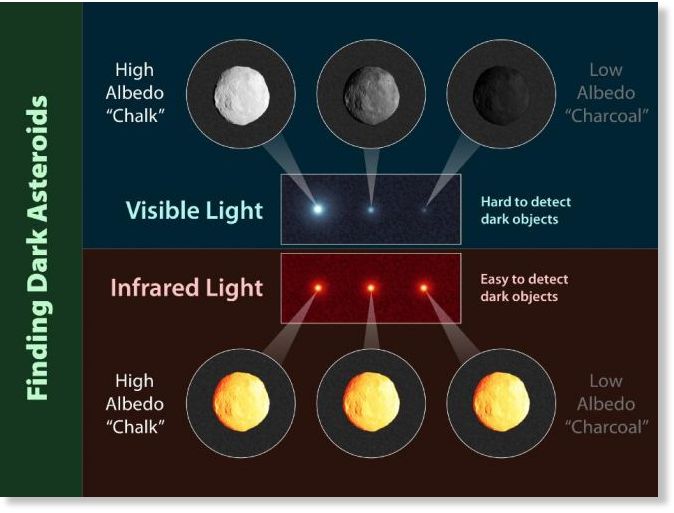
© NASA/JPL-Caltech
This chart illustrates why infrared-sensing telescopes are more suited to finding small, dark asteroids than telescopes that detect visible light.
Though the WISE data reveal only a small decline in the estimated numbers for the largest near-Earth asteroids, which are 3,300 feet (1 kilometre) and larger, they show 93 percent of the estimated population have been found. These large asteroids are about the size of a small mountain and would have global consequences if they were to strike Earth. The new data revise their total numbers from about 1,000 down to 981, of which 911 already have been found. None of them represents a threat to Earth in the next few centuries.
"The risk of a really large asteroid impacting the Earth before we could find and warn of it has been substantially reduced," said Tim Spahr, the director of the Minor Planet Center at the Harvard Smithsonian Center for Astrophysics in Cambridge, Mass.
The situation is different for the mid-size asteroids, which could destroy a metropolitan area if they were to impact in the wrong place. The NEOWISE results find a larger decline in the estimated population for these bodies than what was observed for the largest asteroids. So far, the Spaceguard effort has found and is tracking more than 5,200 near-Earth asteroids 330 feet or larger, leaving more than an estimated 15,000 still to discover. In addition, scientists estimate there are more than a million unknown smaller near-Earth asteroids that could cause damage if they were to impact Earth.
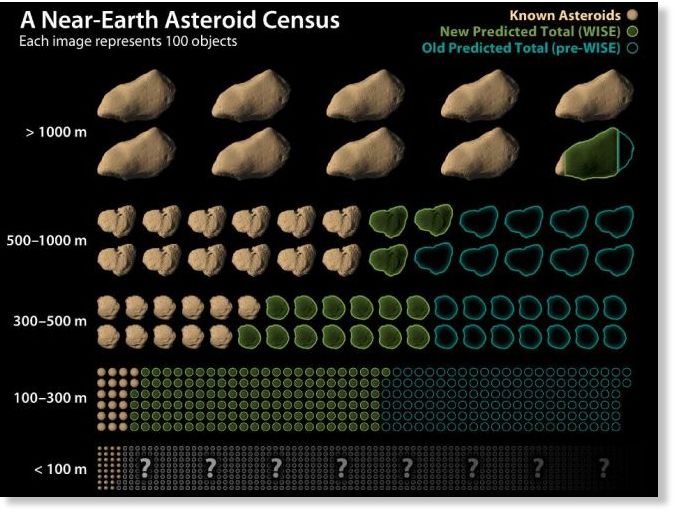
© NASA/JPL-Caltech
This chart shows how data from NASA's Wide-field Infrared Survey Explorer, or WISE, has led to revisions in the estimated population of near-Earth asteroids. The infrared-sensing telescope performed the most accurate survey to date of a slice of this population as part of project called NEOWISE. This allowed the science team to make new estimates of the total numbers of the objects in different size categories. NEOWISE observed more than 500 objects larger than 100-meters (330-feet) wide - what can be thought of as medium to large-size asteroids. Near-Earth asteroids smaller than this size range were not studied, and near-Earth comets will be analyzed at a later time. Asteroid sizes are not drawn to scale in the chart.
Each asteroid image represents about 100 actual objects. Near-Earth asteroids that have already been found are filled in and appear brown. An entire row of asteroid images through the blue outlines shows how many total objects were thought to exist before the NEOWISE survey. The green outlines show the reduced new estimates based on the NEOWISE data.
As the graphic reveals, only a small difference was observed in the estimated total numbers of the largest asteroids - the ones with the potential for global consequences should they impact Earth. For the medium-sized asteroids, which could still destroy a metropolitan area, new estimates predict fewer space rocks than previously thought. Details are listed below.
- For the largest asteroids, larger than 1,000 meters (3,300 feet), NEOWISE data revises the total population down to 981 from a prior estimate of about 1,000. While this is not a dramatic difference, the findings show that NASA has met an initial near-Earth asteroid goal agreed to with Congress in 1998, calling for at least 90 percent of the largest objects to be found. There are an estimated 911 objects of this size range known, which means that NASA has found 93 percent. That leaves roughly 70 of these bodies left to find.
- The NEOWISE data reveals an approximately 44 percent decline in the estimated numbers of medium-sized asteroids, which are defined as those objects between 100 meters and 1,000 meters (330 and 3,300 feet). Estimates now indicate about 19,500, where as 35,000 were thought to exist before.
- The study does not apply to objects smaller than 100 meters (330 feet), but it is estimated that there are more than a million in this size range based on previous studies.
Maryland, US: Possible Meteorite Brings Calls to 911 Center
Cumberland Times-News
Tue, 04 Oct 2011 10:16 CDT
Cumberland - Numerous 911 calls in Allegany and Mineral counties at 4:22 a.m., Tuesday apparently stemmed from a "meteorite passing through the area," according to Roger Bennett, acting director of Allegany County 's 911 center.
"We checked camera footage from schools at Mount Savage, Westmar, Oldtown, Westernport and other locations that showed a flash of light that brightened the whole sky," said Bennett, who reviewed the video footage. He said no objects were visible in any of the videos.
The Allegany County 911 center received about a dozen calls inquiring about the sound of an explosion. Calls were were also reportedly made to the Mineral County 911 center from the Keyser area. However, apparently no calls were made at that time to emergency centers in Garrett, Washington, Bedford and Fayette counties among other locations.
A check of various agencies including the Federal Aviation Administration, Maryland Emergency Management Administration and the Maryland Institute of Emergency Medical Systems Services Statewide Communications Systems produced no information relative to the local 911 calls, according to Bennett.
Bennett also said some unofficial information about the possible meteorite sighting was posted on some websites.
Draconid meteor outburst due October 8th from Comet 21P/Giacobini-Zinner
Tony Phillips
Physorg
Wed, 05 Oct 2011 10:11 CDT
On October 8th Earth is going to plow through a stream of dust from Comet 21P/Giacobini-Zinner, and the result could be an outburst of Draconid meteors.
"We're predicting as many as 750 meteors per hour," says Bill Cooke of NASA's Meteoroid Environment Office. "The timing of the shower favors observers in the Middle East, north Africa and parts of Europe."
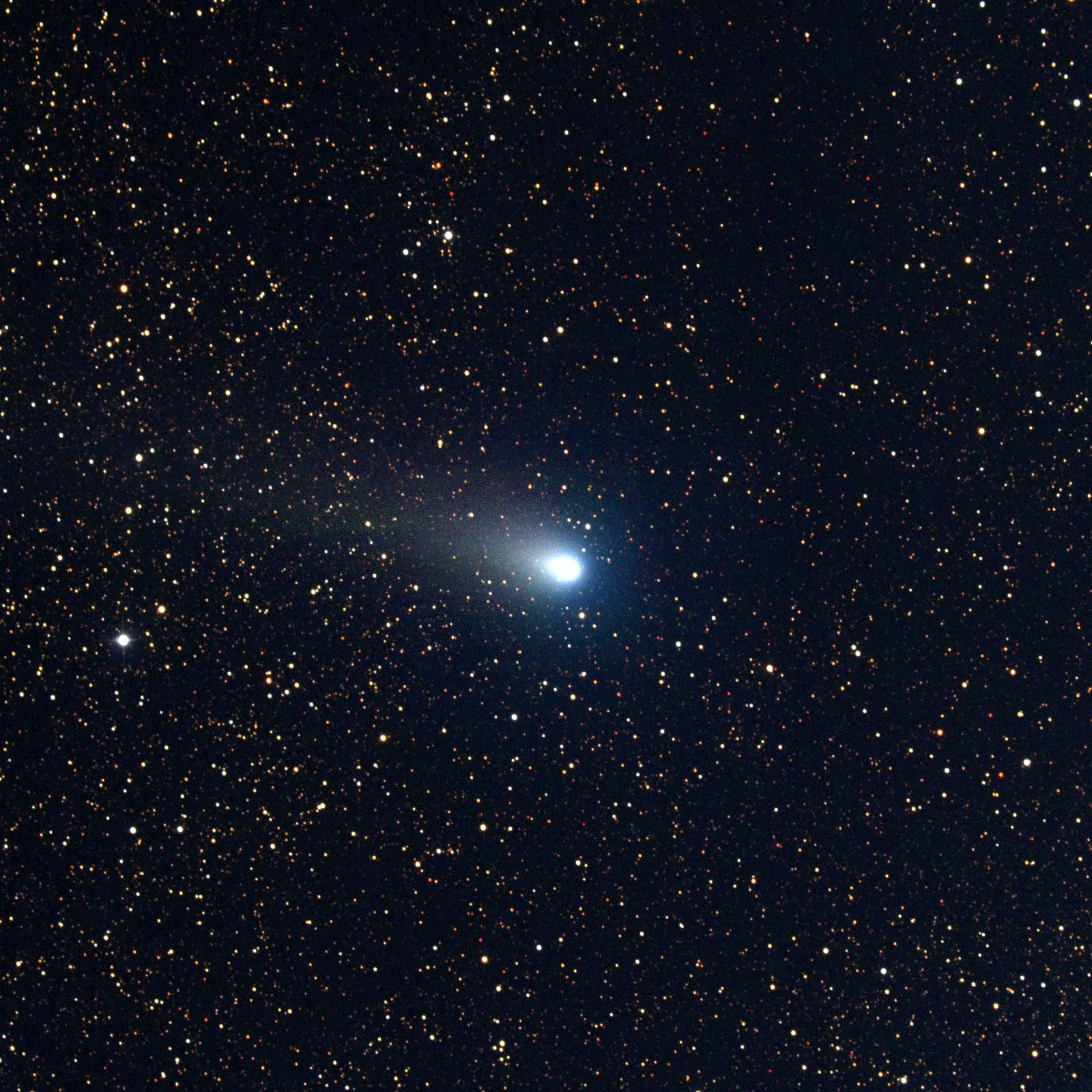
© N.A.Sharp/NOAO/AURA/NSF
Comet Giacobini-Zinner, a fairly frequent visitor to the inner solar system, was captured by the Kitt Peak 0.9-meter telescope on Halloween Night 1998 (UT November 1st, from 02:07 to 03:40). North is up with east to the left. Since the comet was moving across the sky fairly quickly, and since color images are made by combining successive exposures through three different filters, a conventional combination would have either a streaked comet or a set of colored dots for each star. To avoid this, the complete sequence of images, lasting over ninety minutes, was specially processed.
Every 6.6 years Comet Giacobini-Zinner swings through the inner solar system. With each visit, it lays down a narrow filament of dust, over time forming a network of filaments that Earth encounters every year in early October.
"Most years, we pass through gaps between filaments, maybe just grazing one or two as we go by," says Cooke. "Occasionally, though, we hit one nearly head on--and the fireworks begin."
2011 could be such a year. Forecasters at NASA and elsewhere agree that Earth is heading for three or more filaments on October 8th. Multiple encounters should produce a series of variable outbursts beginning around 1600 Universal Time (noon EDT) with the strongest activity between 1900 and 2100 UT (3:00 pm - 5:00 pm EDT).
Forecasters aren't sure how strong the display will be, mainly because the comet had a close encounter with Jupiter in the late 1880s. At that time, the giant planet's gravitational pull altered the comet's orbit and introduced some uncertainty into the location of filaments it has shed since then. Competing models place the filaments in slightly different spots; as a result, estimated meteor rates range from dozens to hundreds per hour.

© MSFC/Meteoroid Environment Office.
Comet dust stream models suggest a succession of peaks in meteor rate between 1600 and 2100 UT on Oct. 9th.
One respected forecaster, Paul Wiegert of the University of Western Ontario, says the meteor rate could go as high as 1000 per hour -- the definition of a meteor storm. It wouldn't be the first time. Close encounters with dusty filaments produced storms of more than 10,000 Draconids per hour in 1933 and 1946 and lesser outbursts in 1985, 1998, and 2005.
Meteors from Comet Giacobini-Zinner stream out of the northern constellation Draco--hence their name. Draconids are among the slowest of all meteors, hitting the atmosphere at a relatively leisurely 20 km/s. The slow pace of Draconid meteors minimizes their danger to satellites and spacecraft and makes them visually distinctive. "A Draconid gliding leisurely across the sky is a beautiful sight," says Cooke.
Unfortunately, many of this year's Draconids will go unseen. Draconids are faint to begin with, and this year they have to complete with an almost-full Moon. Lunar glare will reduce the number of meteors visible from Europe, Africa and the Middle East by 2- to 10-fold. The situation is even worse in North America where the shower occurs in broad daylight - completely obliterating the display.
That isn't stopping a group1 of middle school and high school students from Bishop, California, however. They plan to observe the shower from the stratosphere where the sky is dark even at noontime.
Led by Science@NASA's Tony Phillips, the 15 students have been launching helium balloons to the edge of space since May of 2011. With more than 95% of Earth's atmosphere below the balloon, the sky above looks almost as black as it would from a spacecraft - perfect for astronomy.
"The students are going to attempt to fly one of our low-light meteor cameras in the payload of their balloon," says Cooke. "I hope they catch some Draconid fireballs for us to analyze. They could be the only ones we get."
Stay tuned for results after Oct. 8th.
Did Comet-Born Oceans Hit Earth?
Jason Palmer
BBC
Wed, 05 Oct 2011 01:00 CDT
Comet Hartley 2 was also the subject of the Deep Impact probe study
Comet Hartley 2 contains water more like that found on Earth than all the comets we know about, researchers say.
A study using the Herschel space telescope aimed to measure the fraction of deuterium, a rare type of hydrogen, present in the comet's water.
Like our oceans, it had half the amount of deuterium seen from other comets.
The result, published in Nature, hints at the idea that much of the Earth's water could have initially come from cometary impacts.
Just a few million years after its formation, the early Earth was rocky and dry; most likely, something brought the water that covers most of the planet today.
Water has something of a molecular fingerprint in the amount of deuterium it contains, and only about half a dozen comets have been measured in this way - and all of them have exhibited a deuterium fraction twice as high as the oceans.
Asteroids, by contrast, give rise to the meteors and meteorites that arrive on Earth, making their deuterium fraction more well-established.
Meteoritic material has roughly the same proportion of deuterium that the Earth's oceans contain, and so the assumption has been that if water arrived from elsewhere, it came from asteroids.
Clouded Measure
Until now, all of the comets that have been measured have been so-called Oort Cloud objects, believed to have been formed early in the Solar System's history in the region of the giant planets Neptune and Uranus and kicked out to a great distance as they bumped into the planets and each other.
© SPL
Comets carry much more water than asteroids, but it may or may not be like the water found on Earth
Comet Hartley 2 is the first "Kuiper Belt" object to undergo the deuterium analysis. Kuiper belt objects formed not far outside our Solar System, and comets that originate there have much shorter orbits than those from the Oort Cloud.
An international team using the Herschel telescope to peer at the comet, they found it had a deuterium fraction much closer to that of our oceans.
Report co-author Ted Bergin of the University of Michigan said that opened up the possibility that comets at least contributed to our water supply.
"The reservoir of Earth ocean-like material is much larger than we thought, and it encompasses cometary material, which we hadn't recognised," he told BBC News.
"We have to think really hard and try to get a better understanding of what is going in our Solar System, and whether you can really rule out comets as the source of Earth's water."
They might not be ruled out, but they are not the definitive answer either; much of what we believe happened in the early Solar System is based on computer models.
James Greenwood of Wesleyan University in the US said such models may need adjusting in light of the new evidence - and that more such studies are needed to assess whether many Kuiper Belt objects are like Hartley 2.
"If the short-period comets are all like this one comet, then this could be a significant source of our early water," he told BBC News.
"It opens up a new can of worms for us."
Alessandro Morbidelli of the Observatory of Cote d'Azur argues that the result shows that the distinction between the potential water sources may need to be called into question.
"In the past, scientists thought that these asteroids and comets were completely different classes of bodies. Now, several new results show that primitive asteroids and comets are brothers and sisters," he told BBC News.
"This new view changes at least the semantics of the question on the origin of the Earth's water. The question becomes more technical: 'from which region of the disc and by which dynamical mechanism came the (objects) that delivered the water to the Earth?'"
Herschel has some time left to address the question, but what all the researchers agree is that the Atacama Large Millimeter Array of telescopes in Chile - which has just shown off its first results - will soon be able to resolve these questions with never-before-seen sensitivity.
US, Ohio: Fireball over Sandusky Tuesday night was 'chart-topper'
Sandusky Register
Thu, 06 Oct 2011 16:22 CDT
A gigantic UFO silently burned its way across the Sandusky sky Tuesday night.
That's the story from three Camp Street men who happened to look up just as the object tore through the dark yonder at about 10 p.m.
Robert Lowery, a clerk at the 7-11 store on Camp Street, said he was lugging a pile of cardboard boxes to the Dumpster when a bright object in the sky caught his attention.
"It was about the size of a dinner plate," Lowery said. "You could see the heat coming off it."
At the same time, about two blocks down Camp Street, Montee Prieur and Daniel Harpst were shooting the breeze next to the Camp Street Bar.
"I looked up and this huge fireball went right over us," Harpst said. "It was on fire and had a long streaming tail ... I yelled at my buddy Montee who was sitting right next to me, 'Hey man, check that out.'"
Prieur said he looked up in time to see it.
From their vantage point, the great ball of fire raced overhead for brief seconds before dropping out of sight.
"All I can tell you is it was a UFO," Prieur said. "I've only seen one other thing like it, and that was up in Michigan."
It's anyone's guess how many people saw the mysterious object.
Lowery, in fact, wasn't going to tell anyone about it.
"I was just kinda like, 'That was weird,' but I didn't think much about it," Lowery said. "That's one of those things - if there's nobody else around to see it, you don't go around talking about it. People will think you're crazy."
But when Harpst came in the store all worked up about the sighting, he asked Lowery about it.
Both men agreed on this much: The object came from the southwest, headed northeast and disappeared somewhere over the lake.
"It was really moving, whatever it was," Lowery said. "It looked like it went down somewhere around Johnson Island - that would've been the main stage. I wonder if anybody over there saw it."
The whole show lasted about four seconds.
"God, I wish I had a camera," Harpst said.
Elizabeth Cory, a spokeswoman for the Federal Aviation Administration's Great Lakes Region, said radars didn't show anything extraordinary Tuesday night.
"There was no report of anything unusual last night in that area, or any area for that matter," Cory said Wednesday.
But local astronomers weren't surprised at the sighting.
Lois Wolf, director of the Sidney Frohman Planetarium in Sandusky, said it was probably a meteor that survived upper-atmospheric friction.
"They do go by very fast and would burn white," Wolf said. "It's not uncommon."
Retired planetarium director Dick Speir agreed.
"Some meteors don't burn up in the upper atmosphere, and those that reach the lower levels would produce quite a bit of light," Speir said. "You'd be able to see it for a long ways - there should be other sightings in Erie County at least."
Harpst still isn't convinced of any particular explanation.
"I've seen a lot of strange things in my life, but this was a chart-topper," he said. "And I'll tell you one thing - it wasn't no airplane."
Draconid Meteor Outburst October 8th
Space Weather
Fri, 07 Oct 2011 12:09 CDT
On October 8th, Earth will pass through a network of dusty filaments shed by Comet 21P/Giacobini-Zinner. Forecasters expect the encounter to produce anywhere from a few dozen to a thousand meteors per hour visible mainly over Europe, northern Africa and the Middle East. The meteors will stream from the northern constellation Draco--hence their name, the "Draconids."
Peak rates should occur between 1600 UT and 2200 UT (noon - 6 pm EDT) as Earth grazes a series of filaments nearly intersecting our planet's orbit. Analysts at the NASA Meteoroid Environment Office prepared this plot showing how the meteor rate is likely to vary:
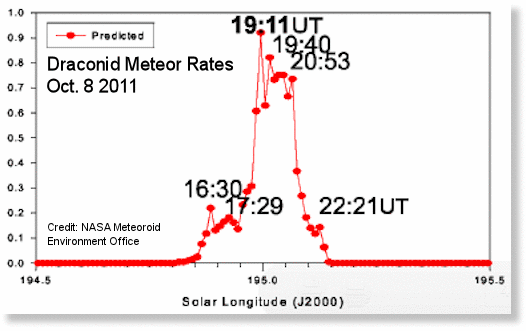
© NASA Meteoroid Environment Office
If the maximum around 1900 UT reaches 1000 meteors per hour, the 2011 Draconids will be classified as a full-fledged meteor storm. The question is, will anyone see it? Bright moonlight over Europe, Africa and the Middle East will reduce the number of visible meteors 2- to 10-fold. The situation is even worse in North America where the shower occurs in broad daylight.
One way to enjoy the Draconids, no matter where you live, is to listen to them. The Air Force Space Surveillance Radar will be scanning the skies over the USA during the shower. When a Draconid passes through the radar beam--ping!--there will be an echo. Tune in to Space Weather Radio for live audio.
In Europe, an international team of scientists plans to observe the shower from airplanes flying at ~30,000 feet where the thin air reduces the impact of lunar glare. In Bishop, California, a team of high school students will launch an experimental helium balloon to higher altitudes, 100,000 feet or more, where the sky is black even at noon. Cameras in the balloon's payload might catch some Draconid fireballs during the peak hours of the outburst.
Stay tuned for updates as Earth approaches the debris zone.
Draconid Meteor Update
Space Weather
09 Oct 2011
According to worldwide observers reporting to the International Meteor Organization, there was indeed an outburst of Draconid meteors on October 8th. Preliminary counts suggest a peak rate of 660 meteors per hour at 2010 UT (4:10 pm EDT). Most Draconids in the outburst were faint, but not all. Göran Fredriksson photographed this fireball splitting the evening twilight over Örnsköldsvik, Sweden:
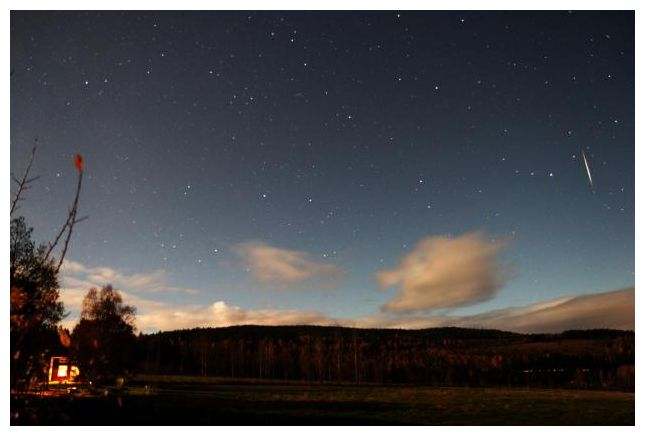
The meteor rate and overall faintness of the display was in good accord with predictions by leading forecasters such as Jeremie Vaubaillon of the Institute for Celestial Mechanics in France and analysts at NASA's Meteoroid Environment Office.
Triple Asteroid Crash Created Sudan Meteorites
Space.com
Fri, 07 Oct 2011 09:18 CDT
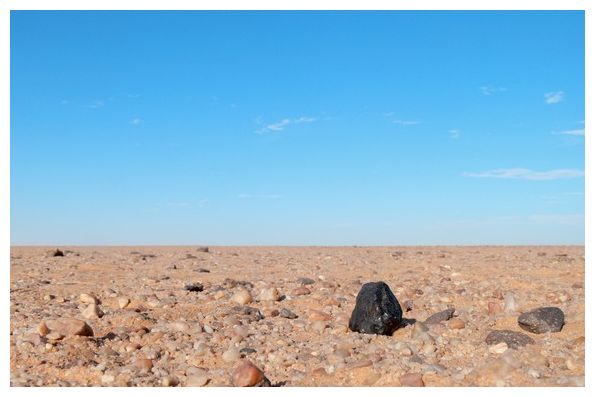
© Peter Jenniskens (SETI Institute/NASA Ames)
The black fragment of Almahata Sitta meteorite number 15 shows up black against the lighter coloured rocks of the Nubian desert in northern Sudan.
Meteorites that fell over Sudan in 2008 could have come from a space rock that was formed by a triple-asteroid pileup - a collision between three different types of space rocks, a new study finds.
Scientists analyzed meteorite fragments that fell to Earth exactly three years ago today, on Oct. 7, 2008, and found that they contain an unusual mix of material from both primitive and evolved types of asteroids.
"Because falls of meteorites of different types are rare, the question of the origin of an asteroid harboring both primitive and evolved characteristics is a challenging and intriguing problem," study leader Julie Gayon-Markt, of the Observatoire de la Cote d'Azur in France, said in a statement.
The meteorites came from asteroid 2008 TC3, which impacted the Earth and rained more than 600 fragments across the Nubian Desert in Sudan. The meteorite fragments are collectively known as Almahata Sitta, which is Arabic for "Station Six," a train station between the Sudanese cities of Wadi Halfa and Khartoum, near where the fragments were found.
"Our recent studies of the dynamics and spectroscopy of asteroids in the main asteroid belt shed light on the origin of the Almahata Sitta fragments," Gayon-Markt said. "We show that the Nysa-Polana asteroid family, located in the inner main belt is a very good candidate for the origin of 2008 TC3."
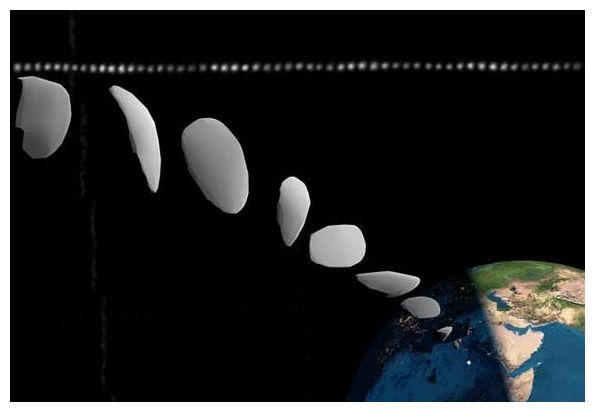
© P. Jenniskens/P. Scheirich
The shape of Asteroid 2008 TC3, a small space rock that hit the Earth in Sudan in October 2008, has been revealed to be something akin to a loaf of bread.
Sifting through the asteroid belt
The Almahata Sitta meteorites were historic because it was the first time that an asteroid was observed in space and tracked as it descended through the Earth's atmosphere, the researchers said. In fact, a weather satellite called Metrosat 8 tracked the path of the asteroid's path using infrared technology.
Primitive asteroids are so called because they are survivors from the tumultuous birth of the solar system and have remained relatively unchanged. These asteroids contain high proportions of hydrated minerals and organic materials, the researchers said.
On the other hand, many other asteroids have undergone intense heating, most likely through the decay of radioactive materials, and the molten magma has separated into an iron core surrounded by a rocky mantle, the scientists explained.
The research was presented today (Oct. 7) at a joint meeting of the European Planetary Science Congress and the American Astronomical Society's Division of Planetary Science in Nantes, France.
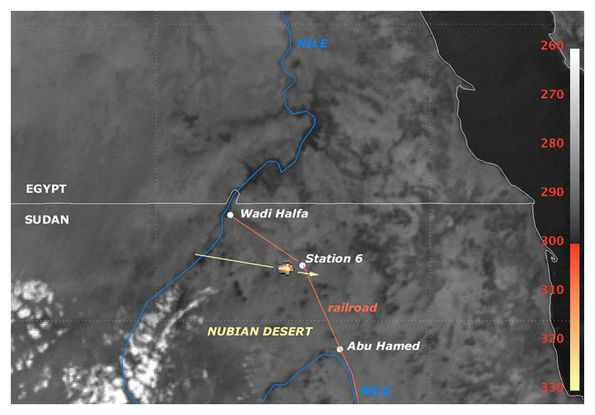
© EUMESTAT
Infrared image taken by the Meteosat 8 satellite of asteroid 2008 TC3 exploding. The path of the asteroid is shown with a yellow arrow; red-yellow blob on arrow is infrared from the explosion.
Three asteroid flavors
The Nysa-Polana family of asteroids, located in the inner main asteroid belt, is divided into three different types: the primitive B-type asteroids, which are relatively rare, stony S-type asteroids, and intermediate X-type asteroids. Both S-type and X-type asteroids have undergone some kind of thermal evolution in their past.
Gayon-Markt and her colleagues found materials from all three Nysa-Polana asteroid types in the Almahata Sitta fragments. Their findings suggest that asteroid 2008 TC3 formed from the impact of an S-type object in the inner main asteroid belt with a B-type object from the Nysa-Polana family. This was followed by a second impact with an X-type asteroid also from the Nysa-Polana family.
"Around seventy to eighty percent of the Almahata Sitta fragments are what we call ureilites," Gayon-Markt said. "Although ureilites show both primitive and evolved characteristics, their spectra in visible light are very similar to B-type primitive objects. The remaining 20 to 30 percent of the Almahata Sitta fragments gather two other kinds of meteorites which are linked to S-type and X-type asteroids. A workable explanation for how asteroid 2008 TC3 could have formed involves low velocity collisions between these asteroid fragments of very different mineralogies."
A Meteor Breaks Up in Earth's Atmosphere
National Journal
Fri, 07 Oct 2011 09:35 CDT
NASA's Marshall Space Flight Center recorded a meteor breaking up in Earth's atmosphere on Sept. 30 at 8:37 p.m. EDT. Watch below.
Also, notice the star-like object moving slowly toward the upper middle of the screen. Orbiting 500 miles above Earth, it's the booster rocket that launched the Russian Cosmos 2219 intelligence satellite in 1992. The empty rocket body can get bright enough to be seen with the naked eye.
US: Four Orange Fireballs Cross Michigan Skies 'at a steady pace'
Roger Marsh
Examiner.com
Sun, 02 Oct 2011 00:00 CDT
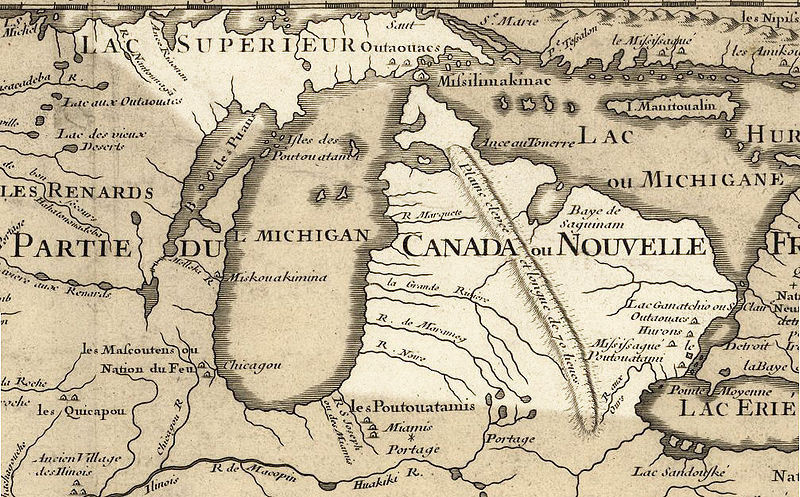
© Wikipedia.
As reported recently in New Jersey, four fireballs crossed Michigan skies on October 1, 2011, and the witness was able to capture all four on video.
A Michigan couple report "four consecutive fireballs" crossed the sky "traveling straight at a steady pace," according to October 2, 2011, testimony from the Mutual UFO Network (MUFON) witness reporting database.
The couple was driving home from dinner when they noticed the first "orange fireball rising up from the horizon."
"It was travelling almost perfectly from north to south," the witness stated. "All you could really see was the v-shaped plume of fire behind it."
The witness described the size of the object.and its path.
"If you extended your arm fully out in front of you, the plume appeared the size of your pinky fingernail. It was travelling straight, at a steady pace."
But then more fireballs were seen.
"What was really odd was that after it traversed the sky and went out of site, about 20 seconds later, another one appeared from the same origin, travelling the exact same path-pace as the first one. Even stranger, this happened a total of four times."
The witness was able to take video of all four fireballs. One piece of video was included with the MUFON report, which was filed on October 2 ,2011. The events occurred on October 1, 2011. No town name was mentioned in the public portion of the report. The above quotes were edited for clarity.
We recently reported on fireballs September 26, 2011, for cases in Oregon and New Jersey - and the New Jersey witness also reported a series of four moving overhead.
Fireballs over Oregon seem controlled as one 'crashes'
New Jersey witness reports four fireballs moved 'like aircraft'
Also in Michigan on October 1, "about 20 to 30 lights" were reported by five witnesses moving north toward Canada in MUFON Case # 32278. "The more I looked, I could see clusters moving in the same direction," the reporting witness stated.
Michigan is a current UFO ALERT 3 rating, with a high number of UFO sightings nationally. Michigan had 40 reports in September 2011 - the 3rd highest reporting state - while California had 86 UFO reports - the highest reporting state in the nation.
You can read more details about other recently reported cases at the UFO Examiner home page.
The following is the unedited and as yet uninvestigated report filed with MUFON. Please keep in mind that most UFO reports can be explained as something natural or manmade. If Michigan MUFON State Director William J. Konkolesky investigates and reports back on this case, I will release an update. Please report UFO activity to MUFON.com.
MI, October 1, 2011 - four consecutive fireballs. MUFON Case # 32277.
My wife and I were driving home from dinner and I noticed an orange fireball rising up from the horizon. It was travelling almost perfectly from north to south. All you could really see was the v-shaped plume of fire behind it.
If you extended your arm fully out in front of you, the plume appeared the size of your pinky fingernail.
It was travelling straight, at a steady pace. What was really odd was that after it traversed the sky and went out of site, about 20 seconds later, another one appeared from the same origin, travelling the exact same path / pace as the first one.
Even stranger, this happened a total of four times!
I have separate videos of each, but attached is a small sample of some of the steadiest video i have, with a good point of reference (tree / streetlight) so you can get an idea of the pace it was moving at.
Electric Universe: Comet Elenin - the Debate that Never Happened
David Talbott
thunderbolts.info
Thu, 06 Oct 2011 22:01 CDT
The comet Elenin, a subject of intense Internet discussion for several months, seems to have disappointed everyone. I speak here not just of the doomsayers, who were awaiting a frightful specter in recent weeks. You might think these folks would be happy that the celebrated intruder faded fast just when it was supposed to be reaching maximum activity. But in these strange times, Doomsday seems a lot more fun than a minor distraction in our cosmic neighborhood.
Also disappointed are the many scientists who expected a more impressive display from Elenin. That expectation seemed well founded based on the growing coma of Elenin in the months following its discovery in December, 2010. And prior space probes sent to comets helped to feed an illusion about the comet's size. The estimates appear to have missed the mark completely.
Strangely, the popular scientific media, insofar as they've shown any interest in Elenin, are satisfied to simply expose the lunacy of Internet fear-mongering. But is that really all we should be discussing here? Elenin has only one connection to "Doomsday." Like every comet, it reminds us of ancient memories of a truly terrifying and destructive Great Comet, the true source of comet fears and Doomsday anxiety - a verifiable cultural conditioning that has persisted for thousands of years. With every appearance of a comet the ancient fear resurfaces, but this fact adds nothing to scientific discussion of Elenin and its fate.
Visions of Nibiru
The little wisp of a comet has no relationship to ancient Babylonian references to "Nibiru," a subject misrepresented up to a cosmic level by the originator of a Nibiru doomsday fantasy - Zecharia Sitchin. From the beginning, the Nibiru concept promoted by Sitchin was a meaningless fiction. A few meager examples of the word exist in Babylonian literature. Nothing in the language suggests either a comet or the rogue planet claimed by Sitchin.
Of course the spokesmen for "good science," a phrase that too often means official dogma, delight in mocking Doomsday musings. But that response can only distract from what should be discussed - the failure of standard comet theory to describe or predict comet behavior over the past 25 years. The ignored fact is that Elenin has only added to the list of comet "misbehavior" - throwing a spotlight once again on mistaken theoretical assumptions.
Just when theory said the comet should have exhibited its greatest activity, it almost disappeared. One would assume from the media silence that the comet's denouement poses no mystery to science. But to those who have come to understand the electrical nature of comets, there is something particularly noteworthy in the fading of Elenin. It is now clear that the original guesses about Elenin's mass were overstated to a spectacular degree. It will certainly not serve the interests of scientific progress to ignore the question posed or turn away from an essential reconsideration of theory.
Explosive brightening
Just a few months ago, Elenin was claimed to be an "average sized long-period comet," with a diameter "between 3 and 4 km."
This opinion was formulated as the comet approached the asteroid belt in its rapid fall toward the Sun. Astronomers observed that Elenin was brightening faster than expected. Between April and August, the dusty coma grew from 80,000 km in diameter to 200,000 km. Applying standard reasoning, observers agreed that Elenin, which seemed rather weak when discovered, was a "typical"-sized comet.
Elenin "looked like it was going to put on a good show," reported Space.com. "Even as recently as Aug. 19, the comet was brighter than predicted."
Then something unexpected happened when, on August 19, the charged particles of a coronal mass ejection struck the comet. In response, the comet flared up dramatically, as seen in the image on the left below. This image was recorded by amateur astronomer Michael Mattiazzo, and cited on the website Astroblog.
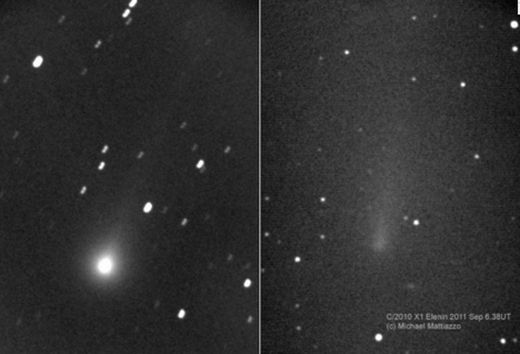
© Michael Mattiazzo - Amateur
astronomer Michael Mattiazzo (Castlemaine, Australia) captured images
of comet Elenin on Aug. 19 (left) after the nucleus was struck by a CME.
The greatly diminished display on the right was captured on Sept. 6,
2011. Astronomers view the second image as an indication of
disintegration.
Ian Musgrave writes, "Shortly after the coronal mass ejection the comet flared up and you could see some beautiful details in the tail, with the tail was twisting about in the solar wind." But over the next few days observers reported a huge decrease in the intensity of the comet, and it appeared that the comet was falling apart.
The electric comet responds
It seems that charged particles from the Sun did what the Sun's heat couldn't do. But did the specialists see a clue in this electrical event? Did anyone remember how, in October 2007, comet Holmes began discharging explosively, brightening by a factor of a million after it was subjected to a huge spike in the solar wind, eventually producing a spectacular coma larger than the diameter of the Sun. The event occurred as Holmes moved away from the Sun, leaving stunned astronomers to offer wild guesses about the cause. No mention of any connection to the surge of charged particles from the Sun, since electrical causes are so clearly outside the astronomers' field of view.
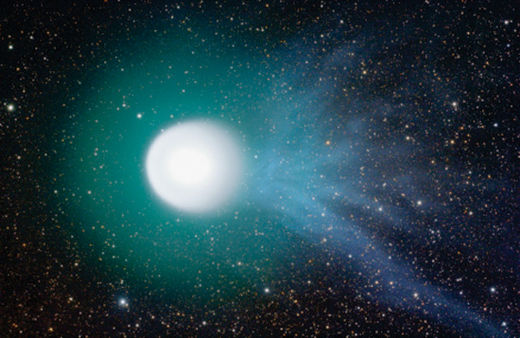
© Ivan Eder - Comet Holmes on November 4, 2007, showing the blue ion tail on the right,taken from Hungary.
Least of all did the the scientific media recall how, in 1991, comet Halley flared up to 300 times its normal brightness while on its long journey away from the Sun, in the distant realm between the orbits of Saturn and Uranus. Here, a surface temperature of -200 ˚C would categorically exclude all "cometary" activity" under standard assumptions. Was it a coincidence that this occurred in the wake of near-record solar outbursts?
As for Elenin, there's apparently little or nothing left of the puny object. We'll know shortly when it, or its residue, emerges from behind the Sun. But consider the implications of Elenin's fate. If astronomers are correct in viewing comets as chunks of icy material moving through an electrically neutral domain of the Sun, imagine the absurdity of thinking that "warming" from the Sun - starting in the icy region beyond the asteroid belt! - could have caused Elenin to evaporate completely within a few months later, while only spending a few weeks inside Earth's orbit. This is the one issue on which the standard model and the electric model deliver the same message: Elenin's size was greatly overestimated.
The underachieving comet
If the comet was much smaller than originally supposed, what caused its noticeable display in the first place, while it was still in the icy region beyond the asteroid belt? At that distance from the Sun, where any appreciable effect of sublimation is doubtful, how did it create the illusion of a respectable size?
The answer - apparently the only plausible answer - is given by the electric comet model. In electrical terms, when a comet drifts in from the outermost regions of the solar system, it is not reasonable to base size estimates on observation of comets with much shorter, less elliptical orbits. Some comets we can visit because they have short periods and we know where they are. But when seen electrically these comets cannot give us an accurate picture of comets as a whole. Electric comets imply that the Sun is the center of an electric field. It is the most positively charged body in the solar system. A comet approaching the Sun from a much more distant region will carry far more negative charge than those orbiting closer to the Sun. And this is why comparisons based on size or strength of cometary activity alone, without reference to orbital characteristics, have never held up and never will.
The negatively charged comet nucleus of Elenin, arriving from the most remote regions of the Sun's influence, was very likely just a small rock, perhaps a hundred meters or less. Moving through the Sun's radial electric field, it began discharging under the electrical stress from rapid entry into a more positively charged environment. As electric arcs to the surface excavated material, accelerating it into a highly diffuse dust cloud, Elenin began to display a coma. That, not any imagined "thermal effects," was why Leonid Elenin detected the tiny comet in December 2010, when it was well beyond the asteroid belt.
Then, on August 19, when the comet was much closer to the Sun, it was struck by the proton-bearing cloud of a CME. Electrical breakdown occurred and the nucleus shattered like an exploding capacitor - just as we've seen in the case of other "inexplicable," exploding comets.
Seeing the obvious
A "3 or 4 km-wide" chunk of ice and dirt could not just disappear at Elenin's distances from the Sun, even with disintegration. Elenin is not a "sun grazer." Its perihelion (closest approach to the Sun) was outside the orbit of Mercury. But what if Elenin was, in truth, a tiny comet, but a strongly charged body for its size? As noted above, since Elenin arrived from a very remote region, electrically-provoked brightening would be expected as it entered a more positively charged region of the heliosphere. For the same reasons, under the impact of a CME, disintegration by electrical breakdown is the obvious interpretation of what occurred.
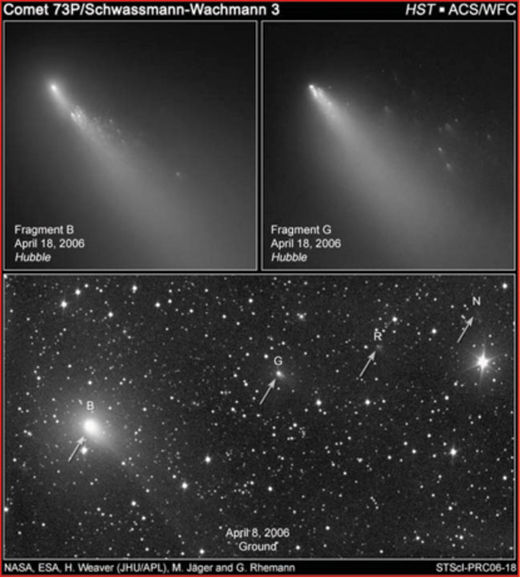
© NASA - The
upper frame of this Hubble Space Telescope image captures the explosive
disintegration of two separate fragments of Comet Schwassman-Wachmann 3
in April, 2006. The relationship of these two fragments to two other
fragments from earlier break-up is evident in the lower Hubble image.
Would a larger comet have disintegrated so completely following the electrical explosion? For comparison purposes, the progressive disintegration of the unpredictable Comet Schwassmann-Wachmann 3 is worth noting. In the image above, the Hubble Space Telescope captured the disintegration of Schwassmann-Wachmann 3 in progress, when it was still out beyond Earth's orbit. Apparently, in this case a comet of more "respectable" size than Elenin exploded into fragments through phases, in the course of two or three orbits, leading to sudden, rapid disintegration of at least two larger fragments in April, 2006.
It seems that when a comet of a more "typical" size disintegrates, it puts on a more lasting and spectacular display. The prolonged disintegration of Comet Schwassman-Wachmann simply underscores the point noted above, that Elenin's disintegration in a bright flash, followed by rapid disappearance of the residue, is the confirmation of a tiny nucleus.
Elenin's predecessor - Comet Linear
A 21st century illustration of this point was the disintegration and disappearance of Comet Linear in 2000. Indeed, Linear's entry into the inner solar system from the outermost regions, its highly eccentric orbit, its brightening, and its demise appear to have anticipated very well the story of Elenin. Compare the two images below to the "before and after" images of Elenin given earlier in this article.
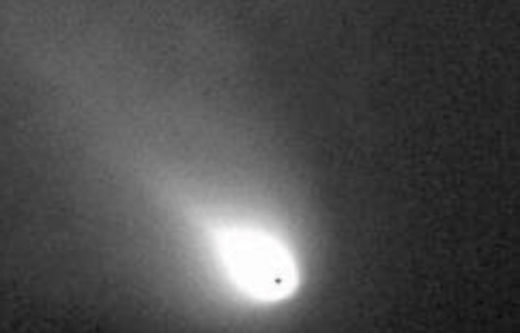
Comet Linear on July 23, 2000, in its "brightest moment" before complete disintegration. http://www.ing.iac.es/PR/AR2000/high_2000.html
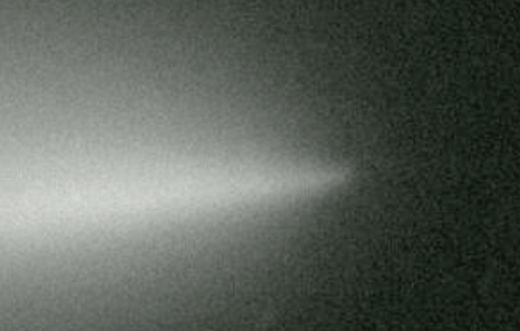
Comet Linear on August 2, 2000 after fragmentation of the nucleus
Comet Linear also provided one other clue to the electric comet. Rocky pebbles and grains of dust can quickly adjust to their electrical environment. With complete disintegration, discharge activity will quickly end. That's what happened to Linear, and very likely what happened to Elenin. Linear was neither a dirty snowball, nor an icy dirtball. With its disintegration, the only appreciable residue was dry dust. In other words, though occasional water ice or other volatiles on a comet cannot be categorically excluded, there is good reason to anticipate that the remains of Comet Elenin will be almost entirely dust. (This will most likely mean that the only "water" in the dust cloud will be the consequence of negatively charged oxygen atoms from the comet combining with hydrogen ions from the solar wind.)
For more than a quarter century now, on every major issue confronting comet science, the record is remarkably clear. No "standard" model has withstood the surprises of the space age. When Donald Brownlee, head of NASA's stardust mission, confessed, "It's a mystery to me how comets work at all," he was simply speaking with the candor that all comet specialists owe to the tax-paying public. Today, in the face of growing public disinterest, this candor is needed more than ever.
A comet holding its integrity year after year, then suddenly shattering at considerable distances from the Sun, was never expected. But what better way to move science forward than to ask: Why? And what better way to re-inspire the space age than to discuss openly and publicly the sweeping evidence for electricity in space?
Source: Comet Elenin—the Debate that Never Happened
October 6, 2011: 50 reports of fireball sightings over Southeastern USA
Robert Lunsford
American Meteor Society
Thu, 06 Oct 2011 06:32 CDT

Huge fireball spotted over Southeastern US on January 12 this year.
The American Meteor Society has so far received approximately 50 reports of a dazzling fireball over the southeastern USA including Florida, Georgia, Alabama and Mississippi. This event occurred near 8:40pm EDT (7:40pm CDT) Thursday evening October 6th. Of the reports received so far, green is the by far the most mentioned color. Vivid green fireballs are not unusual and in the case of slow meteors, such as this one, are usually caused by a particular element such as nickel or copper present in the meteor. The green color observed in swift fireballs are more likely caused by ionized oxygen caused by the passage of the meteor through the atmosphere. The average brightness reported by witnesses was near the light produced by a full moon.
A fireball is a meteor that is larger than normal. Most meteors are only the size of small pebbles. A meteor the size of a softball can produce light equivalent to the full moon for a short instant. The reason for this is the extreme velocity at which these objects strike the atmosphere. Even the slowest meteors are still traveling at 10 miles per SECOND, which is much faster than a speeding bullet. Fireballs occur every day over some parts of the Earth. It is rare though for an individual to see more than one or two per lifetime as they can also occur during the day or on a cloudy night. Observing during one of the major annual meteor showers can increase your chance of seeing another bright meteor.
Fireballs often appear much closer than they really are. The AMS receives countless reports that an object landed just over the hill when in fact it was several hundred miles away and was witnessed over several states. It is your perspective that makes meteors appear to strike the horizon when in fact they are still high in the atmosphere. This is much like a jetliner seen low in your sky. It appears low to you but for someone located many miles away in that direction, the jetliner is passing high overhead. Meteors become visible at approximately 50 miles above the Earth's surface. Friction slows these objects down until they fall below the velocity necessary to produce light. At this point they still lie at least 5 miles high in the sky. They are invisible below this altitude and cannot be seen as they basically freefalling to the ground at 200mph. Very few meteors actually reach the ground as 99.99% completely disintegrate while still 10-20 miles up in the atmosphere.
In the AMS fireball table, refer to event #1137 for 2011.
Clear Skies!
Double-Whammy Knocked Uranus to Its Side
Irene Klotz
Discovery News
Fri, 07 Oct 2011 08:56 CDT
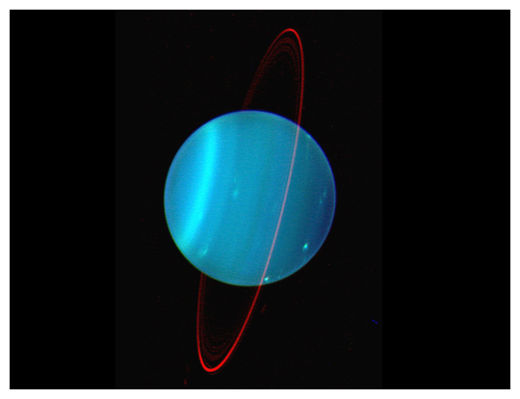
© Lawrence Sromovsky, (Univ. Wisconsin-Madison), Keck Observatory
Near-infrared views of Uranus reveal the extent to which it is tilted.
What toppled giant Uranus, the seventh planet from the sun, to its tilt is a long-standing puzzle. Scientists suspect it was left spinning on its side after a collision with an object about twice the size of Earth.
But that doesn't explain why Uranus's moons spin sideways, relative to their orbital planes, matching almost exactly their parent planet's 98-degree tilt.
Jupiter's spin axis, by comparison is tilted 3 degrees; Earth's, 23 degrees; Saturn and Neptune, 29 degrees.
The answer, suggests a team of scientists, is that Uranus was pummeled more than once. Computer models show a series of impacts by Earth-sized objects could have left Uranus on its side before its moons formed.
A single crash, the researchers say, would have left any moons accumulating from a cloud of materials surrounding Uranus spinning in the opposite direction from how they appear today.
The research has implications for understanding how the solar system -- and other planetary families beyond our solar system -- formed and evolved.
"The formation history of Uranus and Neptune is one of the most important open problems in planetary science. Having shown that giant collisions had to happen frequently on these planets is an important piece of information on the way to understanding their origin," lead author Alessandro Morbidelli, with the Observatory of Cote d'Azur in Nice, France, wrote in an email to Discovery News.
Better images of Uranus's moons probably would provide more clues about how the bodies formed, Morbidelli added.
The idea that Uranus was toppled by a double-whammy raises the question about where the impacting objects came from, points out astronomer Steven Desch, with Arizona State University.
Previous studies show that if the cores of Uranus and Neptune formed closer to the sun than where the planets are today, there would have been enough time for one object about twice the mass of Earth to form just beyond them. But Desch is skeptical there would have been enough time for more than one object to form and then batter Uranus.
"Is it possible to grow more than one object this large though? It seems unlikely," Desch told Discovery News.
Uranus currently orbits about 19 times farther from the sun than Earth. In Desch's model, it and Neptune would have needed to form about 50 to 75 percent closer to the sun to allow for the formation of the impacting body.
Morbidelli's research was presented this week at a planetary sciences meeting in Nantes, France.
Source
Impact On Asteroid Scheila?
Tammy Plotner
Universe Today
Sun, 09 Oct 2011 22:33 CDT
>
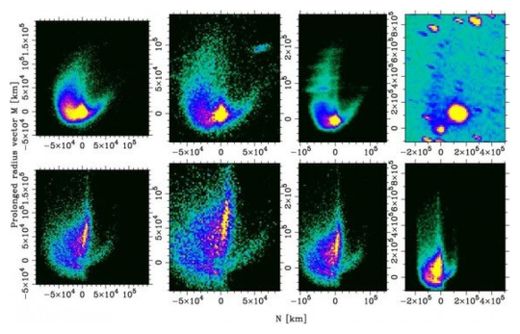
© Fernando Moreno
Left to right): images of (596) Scheila corresponding to 2010 December 13, 14, 17, and 29. The upper row corresponds to the observations, while the lower row to the models. The tails clearly show a bifid pattern with a central spike in the sunward direction, although it is not detectable in the December 29 image. Except for this latter case, the modeled images are rendered using the same color code for the intensities as the corresponding observed images in the top row.
On December 12, 2010, something very unusual happened to asteroid Scheila. For a short period of time, its appearance changed dramatically and it even developed a comet-like tail. Now a group of international scientists headed by Fernando Moreno of the Instituto de Astrofísica de Andalucía in Granada, Spain have created a computer model which may explain this weird activity... an impact.
In results revealed October 7th in Nantes, France at the joint meeting of the European Planetary Science Congress and the American Astronomical Society's Division for Planetary Sciences, the team explained their theory of how this innocent asteroid may have been crashed into by a smaller object. Moreno and his team plotted the brightness curve of Scheila's newly developed "tail" - watching how it declined over a period of weeks. Their conclusion was that Scheila was either responsible for bumping into an uncatalogued object - or the object bumped into it causing a debris trail.
"The model we used involves a very large number of particles ejected from Scheila." explains Moreno. "We took into account gravity from the Sun, pressure radiation on the ejected particles, and Scheila´s gravity, which has a strong effect on the particles in its vicinity owing to its large mass."
Just when did this crash occur? The first indications placed the "asteroid accident" at a period of somewhere between November 11 and December 3, 2001. But, thanks to refined studies the team has placed the smash-up to on - or within - three days of November 27, 2010. With a size of about 110 kilometers across, Scheila isn't very large and the impactor was estimated to be anywhere from 60 to 180 meters in diameter. That's quite enough to send visible pieces flying into space!
"We applied a scaling law that uses impact velocity to indicate the mass of the impactor and ejected material." concludes Moreno. "We know the impact should be about 5 kilometres per second because that's the average velocity of asteroids in the Main Belt. Using this number we predicted both the ejection velocity of the particles (50 to 80 meters per second) and the size of the impactor."
As for asteroid Scheila, she's also a step off the beaten path, too. It belongs to a class known Main-Belt Comets - objects which have orbital characteristics of Main-Belt Asteroids - but sometimes behave like a comet. The reason why they have outbursts still isn't clear. While these new modeling techniques may lend credence to the impact theory, there's also a strong possibility of gaseous emissions. However, astronomers from the University of Maryland and Institute for Astronomy, University of Hawaii have ruled out venting in Scheila's case.
Source: EuroPlanet News.
Read on SOTT.net
First comet found with 'ocean water'
Nicole Casal Moore-Michigan
Futurity
Mon, 10 Oct 2011 14:54 CDT
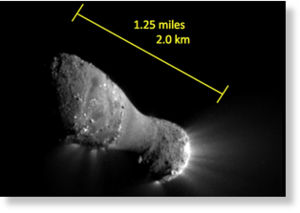
© NASA - Comet Hartley, as imaged by NASA's EPOXI spacecraft.
For the first time, researchers have detected ocean-like water in a comet - new evidence supporting the theory comets delivered a significant portion of Earth's oceans.
"Life would not exist on Earth without liquid water, and so the questions of how and when the oceans got here is a fundamental one," says Ted Bergin, an astronomy professor at the University of Michigan. "It's a big puzzle and these new findings are an important piece."
The findings are reported in the journal Nature.
Bergin is a co-investigator on HiFi, the Heterodyne Instrument for the Infrared on the Hershel Space Observatory. With measurements from HiFi, the researchers found that the ice on a comet called Hartley 2 has the same chemical composition as our oceans. Both have similar D/H ratios. The D/H ratio is the proportion of deuterium, or heavy hydrogen, in the water. A deuterium atom is a hydrogen with an extra neutron in its nucleus.
"We were all surprised," Bergin says.
Six other comets HiFi measured in recent years had a much different D/H ratio than our oceans, meaning similar comets could not have been responsible for more than 10 percent of Earth's water.
The astronomers hypothesize that Hartley 2 was born in a different part of the solar system than the other six. Hartley most likely formed in the Kuiper belt, which starts near Pluto at about 30 times farther from the Sun than the Earth is. The other six hail from the Oort Cloud more than 5,000 times farther out.
The source of earth's oceans has been a subject for debate among astronomers for decades. Until now, asteroids were thought to have provided most of the water. Now, however, Herschel has shown that at least one comet does have ocean-like water.
"The results show that the amount of material out there that could have contributed to Earth's oceans is perhaps larger than we thought," Bergin says.
Herschel, a European Space Agency mission with NASA participation, is an orbiting telescope that allows astronomers to observe at the far-infrared wavelengths where organic molecules and water emit their chemical signatures.
France: Meteorite believed to be more than 4bn years old smashes through roof of home on outskirts of Paris
Kim Willsher
The Guardian
Mon, 10 Oct 2011 12:46 CDT
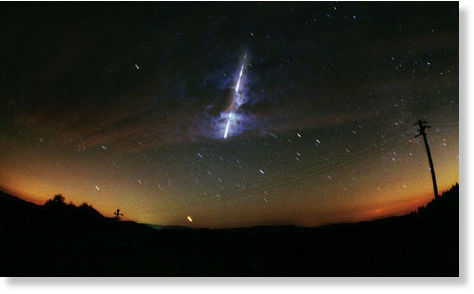
© Nasa/EPA - The meteorite which hit the Comette family home is thought to have come from the asteroid belt between Mars and Jupiter.
When your name is Comette you may get used to jokes about rockets and space and planets. But French schoolboy Hugo Comette, 11, had the last laugh when of all the places, in all the countries on Earth, a piece of rock from outer space landed on his home.
An egg-sized meteorite believed to be 4.57bn years old smashed through the roof of the Comette family home on the outskirts of Paris some time over the summer when everyone was away on holiday.
And there the rock, blackened by its journey through Earth's atmosphere stayed, buried in the roof insulation, until Hugo's mother, civil servant Martine Comette, 32, noticed the roof was leaking and called out someone to fix it.
The roofer took one look at the broken tile and told the Comettes that whatever had smashed their roof tile must have come from the sky. "It would have had to be superman to break a tile in this way," he said. It was only then that the meteorite, weighing 88g (3.5oz), was discovered.
Curious to know exactly what it was, Mrs Comette called out scientist Alain Carion, a mineral expert, who declared it an "exceptional" discovery.
"It's extremely rare. We have had only 50 or so meteorite falls in France over four centuries," Carion told journalists. "We have never found anything like it within an 80km radius of Paris before."
He said the Comettes' meteorite was a piece of chondrite that had come from the belt of asteroids between Mars and Jupiter. Most meteorites recovered on Earth are chondrites. They were formed when dust and small grains present in the early solar system created primitive asteroids. Chondrite meteors include dust believed to predate the formation of our solar system and to have come from elsewhere in the galaxy.
Although they have been told some meteorites sell for up to €1,000 (£860) a gramme, the Comettes say selling theirs is out of the question. "A piece of the history of space of which we know nothing, but which is fascinating, has fallen on us," Mrs Comette, an accountant at the French ministry of finance, told Le Parisien newspaper. "It's like a fairytale, and less likely than winning the lottery, we're told."
Comment: Actually, the odd are much higher than this. The chances are also fairly high for the "raindrops" to morph into a downpour. In this case, the fairytale could turn into a potential nightmare.
Not that the lump of rare chondrite Hugo Comette has been proudly showing off at school has convinced everyone. "I took it to school in a piece of kitchen roll in my satchel, but one friend said he only half believed me when I told him what it was," Hugo said. "He thought it looked like a piece of concrete."
A Meteorite Visits the Comettes
Jason Major
Universe Today
Mon, 10 Oct 2011 22:42 CDT
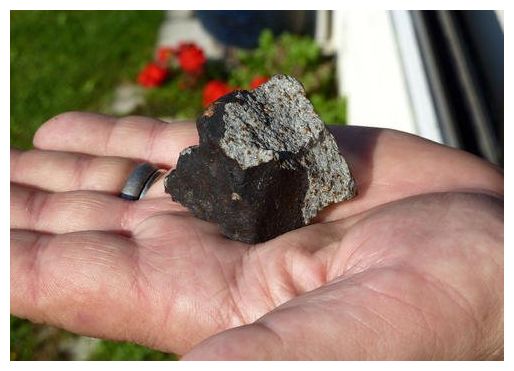
© Universe Today - This egg-sized meteorite broke through the roof of the Comette family.
When your last name is Comette, I'm sure the occasional astronomy-themed joke is never far away. But it's no joke that the Comette family living in Draveil, a suburb south of Paris, was paid a visit by a real extraterrestrial a couple of weeks ago - in the form of an 88-gram (3.5 oz.) meteorite that broke through their roof!
The Comettes were on vacation at the time, so didn't realize their house had been struck by a space rock until they noticed a leak in the roof. When they called in a roofer it was discovered that a thick tile had been completely broken through.
The meteorite was found wedged in insulation.
Mineral scientist Alain Carion investigated the meteorite and determined that it's an iron-rich chondrite, a 4.57-billion-year-old remnant of the early Solar System that most likely came from the main asteroid belt between the orbits of Mars and Jupiter. About 3/4 of all meteorites that have been observed landing on Earth are chondrites.
While obviously not impossible, the odds of your home being hit my a meteorite are incredibly slim. Only 145 meteorites have been documented landing in the US in the past 200 years. On March 26, 2003, just before midnight, hundreds of fragments of a large meteorite fell in the Park Forest area of Chicago. Several fell through roofs of houses and one punched a hole in the roof of the fire station. One large piece weighing about 2.5 kg (5.5 lb) crashed into a bedroom, narrowly missing a boy who was asleep in his bed! On September 23, 2003, a 20 kg (44 lb) stone meteorite tore straight through a two-storey house in New Orleans and came to rest in the basement. (Source: University of New Mexico Institute of Meteoritics.)
Only about 50 meteorites have been found in France over the past four centuries, and none has ever before been discovered less than 80 km (50 miles) from Paris.
While they could attempt to sell the meteorite that struck their home, possibly fetching several hundred euros for it, the Comettes have decided to keep their otherworldly visitor.
"A piece of the history of space of which we know nothing, but which is fascinating, has fallen on us," Mrs. Comette told the Le Parisien newspaper. "It's like a fairytale, and less likely than winning the lottery, we're told."
Saturn's rings tell a comet's tale
Nadia Drake
ScienceNews.org
Tue, 11 Oct 2011 14:15 CDT

© NASA
Ripples testify to 14th century collision
During the 1300s, the Black Death was savaging Europe, England and France were locked in the Hundred Years' War and Chaucer was penning his Canterbury Tales. Meanwhile, more than a billion kilometers away, a comet careened toward Saturn and disintegrated, dropping dusty clouds of debris on the giant planet's iconic rings, creating rippled cometary footprints.
The ripples from that cataclysmic event can still be detected today, electrical engineer Essam Marouf reported October 4 during the joint meeting of the European Planetary Science Congress and the American Astronomical Society's Division for Planetary Sciences.
Marouf, a professor at San Jose State University in California and a member of the Cassini science team, described how the probe beamed radio waves back to Earth through the innermost part of Saturn's C ring, a tenuous inner band in the planet's ring system. The radio waves revealed what Marouf calls a "very unusual kind of addition" to the normal ring structure. "There were highly regular little wiggles that rippled over hundreds of kilometers in a very specific pattern," Marouf says.
The rippling region contains two different waves, one that repeats every 1.2 kilometers and another that repeats every 1.3 kilometers. Though curious, similar wiggles do appear elsewhere in the outer solar system. Scientists traced a similar structure in Jupiter's rings - spied by the Galileo probe - to debris littered by comet Shoemaker-Levy 9 as it crashed into the solar system's largest planet in 1994.
Saturn's C ring also features a longer rippling structure imaged by Cassini and reported earlier this year. Scientists think these longer undulations - between 30 and 50 kilometers - were caused by an impact event in 1983.
Using that information, Marouf and his team were able to determine how long ago the ripples were created, since wavelengths shrink predictably and elderly ripples are more closely packed together.
Rewinding that shrinking process revealed that the newly observed ripples are 600 years older than those born in the early 1980s. "They date back to about the late 1300s," Marouf says. "And there is very clear evidence for two events, not one, separated by about 50 years."
"This is such an amazing result," says Mark Showalter of the SETI Institute in Mountain View, Calif., who recently linked the Jovian ripples with the comet. "Two events is really a hint that this is a cometary kind of thing. Some object got captured into orbit, made two close passages. Survived the first, not totally damaged - then 50 years later it came back in and that was the end of it."
Did A Comet Cause Solar Explosion? Hardly, Ignorant Experts Say
Mike Wall
SPACE.com
Tue, 11 Oct 2011 15:47 CDT

© SOHO
A huge solar eruption that occurred right after a comet plunged into the sun was likely a coincidence, experts say.
The so-called "sungrazing" comet streaked toward the sun Saturday (Oct. 1) and disintegrated after getting too close. The sun then unleashed a massive eruption of solar plasma known as a coronal mass ejection, which can rocket through space at 3 million mph (5 million kph). But there's no reason to think the two dramatic events were related, scientists said.
"There still remains zero evidence for a link between sungrazing comets and coronal mass ejections (CMEs) that can't be better explained than by simple coincidence," Karl Battams of the U.S. Naval Research Laboratory wrote in a blog post Tuesday (Oct. 4). [Stunning Photos of Solar Flares & Sun Storms]
Solar astronomers with the sun-watching Solar and Heliospheric Observatory agreed.
"The question of whether a sungrazing comet can somehow trigger a coronal mass ejection is an intriguing one," SOHO scientists wrote in a website update this week. "So far, the feeling is that [the] apparent relationship between some comets and some mass ejections is simply one of coincidence."
No mechanism known
CMEs and other solar storms are magnetically driven, erupting after magnetic field lines on the sun twist, break and reconnect.
Scientists don't know how a comet could spur such a process, wrote Battams, who does computer processing for SOHO and runs the sun observatory's comet-sighting website for the Naval Research Lab.
The likelihood seems more remote when you consider that death-diving comets rarely actually reach the sun's surface. Instead, they generally break up after veering too close.
And sungrazing comets tend to be small.
The comets spotted by SOHO have cores about 330 feet (100 meters) wide at most, according to Battams. The sun, on the other hand, is about 865,000 miles (1.39 million kilometers) across.
"I'm lucky enough to be surrounded by some of the best solar physicists in the world, and none of them can think of a reasonable mechanism in which physics would allow this event to be initiated by any comet, let alone such a tiny one," Battams wrote.
Researchers also have a pretty good idea of where Saturday's CME originated, he added, and it looks like the death-diving comet didn't come anywhere close to that spot.
Finally, Battams has gone through the SOHO data and found many sundiving comets whose death plunge was not followed by a CME. But the times when the two dramatic events occur one after the other tend to stick out in people's minds, he added.
An active sun
The most reasonable explanation, Battams and other scientists say, is that when sungrazing comets and solar storms coincide, that's all it is: mere coincidence. [The Sun's Wrath: Worst Solar Storms in History]
When the sun is active, it can unleash a dozen or so CMEs per day, and perhaps even more, Battams wrote. And sungrazing comets aren't all that rare, either. During a 10-day stretch in December 2010, for example, at least 25 comets hurled themselves into the sun.
So it would be surprising if at least some CMEs didn't occur shortly after a comet plunge, just by chance alone. And that could start happening more and more, because the sun is in an active phase right now, researchers said.
"At this stage of the solar cycle, the sun is producing many mass ejections - in fact there were several earlier in the day [Saturday] - and it probably just happened by chance that one of them was around the same time as the approach of the comet," researchers with SOHO, which is a joint effort of NASA and the European Space Agency, wrote in an update Monday (Oct. 3).
"Some researchers have been looking for a more direct relationship, but nothing as yet has come out of these efforts," they added.
Activity in the current cycle, known as Solar Cycle 24, should peak around 2013, experts say.
Asteroid Vesta Has Mountain Three Times as Tall as Everest
Victoria Jaggard
National Geographic News
Wed, 12 Oct 2011 00:00 CDT
New view shows huge peak on Vesta's south polar region.

© Caltech/UCLA/MPS/DLR/IDA/NASA - Vesta's south polar region, as seen in a digital model based on NASA images.
The asteroid 4 Vesta hosts a mountain three times as high as Mount Everest, seen in a new picture from NASA's Dawn spacecraft.
The unexpected peak rises from the center of a crater in the asteroid's south polar region. The mountain is about 13 miles (22 kilometers) high and spreads about 112 miles (180 kilometers) at its base.
By contrast, the biggest known mountain in the solar system, Mars's Olympus Mons, stands 16 miles (25 kilometers) high and spreads 374 miles (624 kilometers).
"Vesta is full of surprises, and no more so than in the southern polar region," Paul Schenk, a Dawn participating scientist at the Lunar and Planetary Institute in Texas, said today during a press briefing.
"We had indications before arrival that the south polar region was going to be interesting," Schenk added. For instance, "Hubble pictures show a dimple there, but at [the space telescope's] resolution it's hard to tell what's going on."
With the new, higher-resolution data from Dawn, scientists can see the "dimple" is really an impact crater - dubbed the Rheasilvia Basin - that's about 295 miles (475 kilometers) wide and that's dominated by the massive central mound.
"Vesta is really a small world that is quite unique and has exceeded our expectations," Carol Raymond, Dawn's deputy principal investigator at NASA's Jet Propulsion Laboratory, said at the briefing.
Flattening an Asteroid
At about 330 miles (529 kilometers) wide, Vesta is the second largest body in the main asteroid belt, a ring of solar system "leftovers" that lies between the orbits of Mars and Jupiter.
Dawn entered orbit around Vesta in July and will spend a full year collecting data before moving on to the dwarf planet Ceres, the largest body in the main belt.
Using some of the high-resolution pictures of Vesta taken so far, JPL scientists created an image that gives an angled view of Vesta's south polar region, to highlight its three-dimensional topography.
Like straightening out an orange peel, this view of Vesta's surface has been digitally flattened so that features such as the high mountain don't disappear over the horizon of the nearly round asteroid.
Vesta a Peek at Baby Earth?
Studying features such as the giant polar mountain on Vesta should help scientists trace the asteroid's geologic history, possibly giving a glimpse at how our solar system formed.
Previous studies of meteorites from Vesta showed that the space rock's pitted surface was once coated by basaltic lava flows, hinting that Vesta hosted a global magma ocean similar to the one that likely existed on Earth's moon.
In fact, Vesta is thought to be a protoplanet - a baby world whose growth was stunted by gravitational interactions from Jupiter, as that planet grew to become the massive gas giant we see today.
The results of the Dawn mission, according to NASA, can therefore offer clues to what rocky planets such as Earth and Mars might have looked like in the early days of the solar system.
"We are finding - and expect to further document - that Vesta has undergone planetary processes," JPL's Raymond said.
Time-lapse trifecta! Photo captures meteor, Milky way and Northern Lights
Jonathan Woods
MSNBC
Thu, 13 Oct 2011 12:45 CDT
A meteor, the Milky Way and the Northern Lights. Capturing just one of these natural beauties in a photo is a feat many photographers would be proud of.
Amateur photographer Tommy Eliassen struck photo gold in this beautifully composed image he shot in Ifjord, Finnmark, Norway.
Eliassen made the photo on Sept. 25 using a Nikon D700 with a wide angle lens and long exposures between 25-30 seconds.

© Tommy Eliassen/Caters News Agency - A meteor streaks across the Milky Way adjacent to a display of the Northern Lights in Finland.
In an interview with Caters News, The 33-year-old, who capitalized on a narrow window of clear skies, talked about the experience.
"I quickly went and took some pictures in a regular spot of mine, and thought to myself that I had got some good aurora shots and also some separate good milky way shots. But just as the clouds started to come in over the mountains I noticed this faint aurora lining up perfectly beside the milky way. Normally the lights from the aurora is much, much stronger than the lights from the stars, so getting the right exposure on both is difficult. But it was ideal conditions - almost once in a lifetime".He was able to snap seven images of the scene before clouds moved back in.
"I was so focused on getting it right that I didn't think about it at the time. But afterwards I realised that this was something special and that it might be years before I get an opportunity like it again," he said.
Asteroid Near Earth Discovered by Amateur Astronomers
Mike Wall
Space.com
Thu, 13 Oct 2011 08:46 CDT
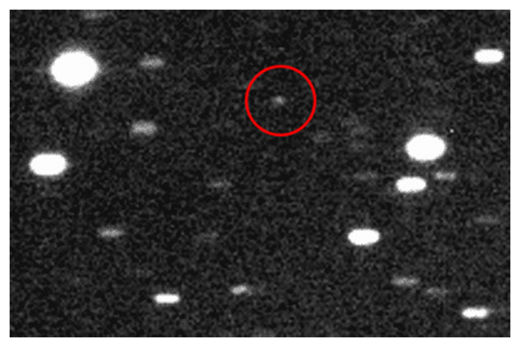
© ESA/TOTAS Survey Team - Observations coordinated by ESA's Space Situational Awareness programme have led to the discovery of a previously unknown near-Earth object, asteroid 2011 SF108 in September 2011. The asteroid orbits the sun in a path that brings it within about 18 million miles (30 million km) of Earth.
A team of amateur astronomers has discovered a previously unknown asteroid in orbit that brings it near the Earth, highlighting the contributions regular folks can make to planetary defense, scientists announced Wednesday (Oct. 12).
The skywatchers spotted the asteroid, which is known as 2011 SF108, in September using a telescope in the Canary Islands. While 2011 SF108's orbit appears to bring it no closer to Earth than about 18 million miles (30 million kilometers), it still qualifies as a near-Earth object - the class of space rocks that could pose a danger to our planet.
The team took advantage of an observation slot sponsored by the European Space Agency's Space Situational Awareness (SSA) program to make the find, according to an ESA announcement.
"As volunteer work, it is very rewarding," said Detlef Koschny, head of near-Earth object activity for SSA, in a statement. "When you do spot something, you contribute to Europe's efforts in defending against asteroid hazards."
Amateurs make a find
Asteroid 2011 SF108 was discovered by the Teide Observatory Tenerife Asteroid Survey (TOTAS) team, a group of 20 skywatching volunteers. They used the 1-meter telescope at the European Space Agency's Optical Ground Station on Tenerife in the Canary Islands.
Specifics on the asteroid's estimated size were not detailed in the ESA announcement.
The telescope observed for four nights, running automated asteroid surveys using software developed by amateur astronomer and computer scientist Matthias Busch from the Starkenburg Amateur Observatory in Heppenheim, Germany.
Busch's software flags potential space rocks, but the finds must be confirmed by human eyes. The software scored a hit during the observing session of Sept. 28 and 29, researchers said.
"Images are distributed to the entire team for review, and any one of them could be the discoverer of a new asteroid," Koschny said. "This time, the luck of the draw fell to Rainer Kracht."
Kracht, a retired schoolteacher who lives in Elmshorn, Germany, is therefore 2011 SF108's official discoverer. He now has found 46 asteroids, researchers said.
To date, about 8,000 near-Earth objects have been discovered worldwide, but many thousands more are suspected to exist. Astronomers are keen to find as many of them as possible, so they can better assess the chance that a big, dangerous space rock will slam into Earth sometime soon.
Since starting their SSA-sponsored survey work in January 2010, the TOTAS amateur astronomers have identified nearly 400 candidate asteroids, 20 of which have been confirmed and named, researchers said.
Determing the orbit
After examining telescope images from three separate nights, the TOTAS team was able to determine 2011 SF108's orbit well enough to declare it a near-Earth object.
The team sent news of its find to the Minor Planet Center in Cambridge, Mass., the worldwide clearinghouse of information about comets and asteroids.
While 2011 SF108 appears not to pose much risk to Earth for the foreseeable future, further observations could help refine its orbit and our assessment of just how dangerous it might be, researchers said. But for now, the team can bask in the glow of discovery for a spell.
"It was really an exciting moment when I saw 'our' asteroid appearing on my computer screen," Koschny said. "It confirms the excellent quality of work done by the entire TOTAS team."
Debris of "Doomsday" comet to swing by Earth on Sunday
Mike Wall
CBS News / SPACE.com
Fri, 14 Oct 2011 13:21 CDT
The moment long feared by conspiracy theorists is nearly upon us: The "doomsday comet" Elenin will make its closest approach to Earth Sunday (Oct. 16). Or what's left of it will, anyway.

© NASA/JPL-Caltech - Trajectory of comet Elenin
Comet Elenin started breaking up in August after being blasted by a huge solar storm, and a close pass by the sun on Sept. 10 apparently finished it off, astronomers say. So what will cruise within 22 million miles (35.4 million kilometers) of our planet Sunday is likely to be a stream of debris rather than a completely intact comet.
And the leftovers of Elenin won't return for 12,000 years, astronomers say.
"Folks are having trouble finding it, so I think it's probably dead and gone," said astronomer Don Yeomans of the Near-Earth Object Program Office at NASA's Jet Propulsion Laboratory in Pasadena, Calif.
That means it probably won't present much of a skywatching show Sunday, scientists have said.
The doomsday comet
Elenin's apparent demise may come as a relief to some folks, since apocalyptic rumors circulating on the Internet portrayed the comet as a major threat to Earth.
One theory claimed Elenin would set off havoc on Earth after aligning with other heavenly bodies, spurring massive earthquakes and tsunamis. Another held that Elenin was not a comet at all, but in fact a rogue planet called Nibiru that would bring about the end times on Earth. After all, the comet's name could be taken as a spooky acronym: "Extinction-Level Event: Nibiru Is Nigh."

© Michael Mattiazzo/Space.com - Two images of comet Elenin taken on Aug. 19 (left) and Sept. 6, 2011. The images show a rapid dimming in the comet
Those ideas were pure nonsense, Yeomans said.
"Elenin was a second-rate, wimpy little comet that never should have been noted for anything, really," he told SPACE.com. "It was not even a bright one."
Elenin's remains will not be the only objects about to make their closest pass of Earth. One day after the Elenin flyby, the small asteroid 2009 TM8 will zip close by. Like Elenin, it poses no risk of striking our home planet.
Asteroid 2009 TM8 is about 21 feet (6.4 meters) wide and the size of a schoolbus. It will come within 212,000 miles of Earth - just inside the orbit of the moon - when it zips by on Monday morning (Oct. 17).
Say goodbye to Elenin
Elenin was named after its discoverer, Russian amateur astronomer Leonid Elenin, who spotted it in December 2010. Before the icy wanderer broke up, its nucleus was likely 2 to 3 miles (3 to 5 km) in diameter, scientists say.
Elenin never posed any threat to life on Earth, Yeomans said. It was far too small to exert any appreciable influence on our planet unless it managed to hit us.
"Just driving to work every day in my subcompact car is going to have far more of a gravitational effect on Earth than this comet ever will," Yeomans said.
Elenin's supposed connection to earthquakes was just a correlation, and a weak one at that, he added. Relatively strong earthquakes occur every day somewhere on Earth, so it's easy -- but not statistically valid -- to blame some of them on the comet's changing position.
Yeomans views the frenzy over Elenin as a product of the Internet age, which allows loud and often uninformed voices to drown out the rather more prosaic results that scientists publish in peer-reviewed journals.
"It's a snowball effect on the Web," Yeomans said. "You get one or two folks who make an outrageous claim, and a bunch of others pile on. Some folks are actually making a living this way."
Elenin's crumbs will soon leave Earth in the rear-view mirror, speeding out on a long journey to the outer solar system. But Yeomans doesn't think the departure will keep the conspiracy theorists down for long.
"It's time to move on to the next armageddon," he said.
Was the "First Photographed UFO" a Comet?
Jon Voisey
Universe Today
Fri, 14 Oct 2011 20:01 CDT
On August 12th, 1883, Mexican astronomer José Bonilla was preparing to study the Sun at the recently opened Zacatecas Observatory. However, the Sun's surface was marred by numerous objects quickly travelling across its disk. Over the course of the day and the next, Bonilla exposed several wet plates to take images of the 447 objects he would observe. They weren't released publicly until January 1st, 1886 when they were published in the magazine L'Astronomie. Since then, UFOlogists have crowed these photographs as the first photographic evidence of UFOs. The chief editor of L'Astronomie passed the observations off as migrating animals, but a new study proposes the observation was due to the breakup of a comet that nearly hit us.
The only piece of evidence the authors, led by Hector Manterola at the Universidad Nacional Autónoma de México, use to suggest that this was a comet in the process of breaking up, was the descriptions of the objects as being "fuzzy" in nature and leaving dark trails behind them. Assuming this were the case, the authors consider how close the object would have been. Since astronomers at observatories in Mexico City, or Puebla had not reported the objects, this would imply that they did not cross the disc of the Sun from these locations due to parallax. As such, the maximum distance the object could have been is roughly 80,000 km, roughly 1/5th the distance to the moon.
But the team suggests the fragments may have passed even closer. By the time comets reach the inner solar system, they have a significant velocity of some tens of kilometers per second. In such a case, to transverse the disc of the Sun in the time reported by Bonilla (a third to a full second), the object would have been, at most, at a distance of ~8,000km.
At such distances, the overall size of the fragments would be in rough agreement of sizes of other fragmented comets such as 73P/Schwassmann-Wachmann 3, which gave off several fragments in 2006. Based on the number of fragments, estimated sizes, and density of an average comet, the authors estimate that the mass may be anywhere between 2 x 1012 and 8 x 1015 kg. While this is a very large range (three orders of magnitude), it roughly brackets the range of known comets, again making it plausible. The upper range of this mass estimate is on par with Mars' moon Deimos, which is generally held to be similar in mass to the progenitor of the impact that killed the dinosaurs.
One oddity is that one would likely expect such a close breakup to result in a meteor storm. The timing of these events is just before the annual Perseid meteor shower, but reports for that year, such as this one, do not depict it as being exceptional, or having a different radiant than should be expected. Instead, it notes that 157 of the 186 meteors observed on the 11th were definitively Perseids, and that the "year's display cannot be reckoned as a fine one by any means." Meanwhile, the Leonid meteor shower (peaking in November), was exceptional that year, generating an estimated 1,000 meteors an hour, but again, no records seem to indicate an unusual origin.
In total, I find the characterization of Bonilla's observation as a compet plausible, but generally unconvincing. However, if it were a fragmented comet, we're very lucky it wasn't any closer.
Halley's Comet to Put on Meteor Show Next Week
Joe Rao
SPACE.com
Fri, 14 Oct 2011 20:13 CDT
If you step outside before dawn during the next week or so, you might try to catch a view of some "cosmic litter" that has been left behind in space by Halley's Comet: the Orionid meteor shower.
The Orionids can best be described as a junior version of the famous Perseid meteor shower. This year's Orionids show is scheduled to reach its maximum before sunrise on the morning of Oct. 22. The meteors are known as "Orionids" because the fireballs seem to fan out from a region to the north of Orion's second brightest star, ruddy Betelgeuse.

© NASA courtesy of Meteor Physics Group, University of Western Ontario
A 2010 Orionid meteor, seen over Western Ontario, Canada. A waxing gibbous moon shines brightly at the left side of the image.
A 2010 Orionid meteor, seen over Western Ontario, Canada. A waxing gibbous moon shines brightly at the left side of the image.
Currently, Orion appears ahead of us in our journey around the sun. The constellation does not completely rise above the eastern horizon until after 11 p.m. local daylight time. At its best, several hours later around 5 a.m., Orion will be highest in the sky toward the south.
US: Maryland Residents surprised by sonic boom
Delmarva Now
Fri, 14 Oct 2011 17:29 CDT
Berlin, Maryland - According to the Worcester County Fire Marshal's Office, the loud noise heard throughout the north end of the county this morning was a sonic boom.
The noise heard from at least West Ocean City to Bishopville was a sonic boom, according to Worcester County Public Information Officer Kim Moses, but officials don't know what agency the associated aircraft was from.
Shortly after the roughly 9:30 a.m. sound, Maryland State Police said a variety of agencies sent officers out to investigate the loud sound that shook roofs but no one was able to determine the cause.
Comment: Another meteorite exploding in the atmosphere perhaps?
Billion Tonne Comet May Have Missed Earth By A Few Hundred Kilometres in 1883
Technology Review
Tue, 18 Oct 2011 14:53 CDT

© Unknown - Schwassmann-Wachmann 3 comet which broke apart as it re-entered the inner Solar System in 2006
A re-analysis of historical observations suggest Earth narrowly avoided an extinction event just over a hundred years ago
On 12th and 13th August 1883, an astronomer at a small observatory in Zacatecas in Mexico made an extraordinary observation. José Bonilla counted some 450 objects, each surrounded by a kind of mist, passing across the face of the Sun.
Bonilla published his account of this event in a French journal called L'Astronomie in 1886. Unable to account for the phenomenon, the editor of the journal suggested, rather incredulously, that it must have been caused by birds, insects or dust passing front of the Bonilla's telescope. (Since then, others have adopted Bonilla's observations as the first evidence of UFOs.)
Today, Hector Manterola at the National Autonomous University of Mexico in Mexico City, and a couple of pals, give a different interpretation. They think that Bonilla must have been seeing fragments of a comet that had recently broken up. This explains the 'misty' appearance of the pieces and why they were so close together.
But there's much more that Manterola and co have deduced. They point out that nobody else on the planet seems to have seen this comet passing in front of the Sun, even though the nearest observatories in those days were just a few hundred kilometres away.
That can be explained using parallax. If the fragments were close to Earth, parallax would have ensured that they would not have been in line with the Sun even for observers nearby. And since Mexico is at the same latitude as the Sahara, northern India and south-east Asia, it's not hard to imagine that nobody else was looking.
Manterola and pals have used this to place limits on how close the fragments must have been: between 600 km and 8000 km of Earth. That's just a hair's breadth.
What's more, Manterola and co estimate that these objects must have ranged in size from 50 to 800 metres across and that the parent comet must originally have tipped the scales at a billion tonnes or more, that's huge, approaching the size of Halley's comet.
That's an eye opening re-examination of the data. Astronomers have seen a number of other comets fragment. The image above shows the Schwassmann-Wachmann 3 comet which broke apart as it re-entered the inner Solar System in 2006. There's no reason why such fragments couldn't pass close by Earth.
One puzzle is why nobody else saw this comet. It must have been particularly dull to have escaped observation before and after its close approach. However, Manterola and co suggest that it may have been a comet called Pons-Brooks seen that same year by American astronomers.
Manterola and co end their paper by spelling out just how close Earth may have come to catastrophe that day. They point out that Bonilla observed these objects for about three and a half hours over two days. This implies an average of 131 objects per hour and a total of 3275 objects in the time between observations.
Each fragment was at least as big as the one thought to have hit Tunguska. Manterola and co end with this: "So if they had collided with Earth we would have had 3275 Tunguska events in two days, probably an extinction event."
A sobering thought.
Ref: Interpretation Of The Observations Made In 1883 In Zacatecas (Mexico): A Fragmented Comet That Nearly Hits The Earth
Ancient Meteorite Blast Resembled Volcanic Eruption
OurAmazingPlanet
Tue, 18 Oct 2011 11:36 CDT

© Branney and Brown 2011 (Journal of Geology 199, 275-292)>
Meteorite impact ejecta (left) compared with volcanic deposits (right) showing closely similar structures made of dust particles. The top two photos show accretionary lapilli in density current deposits, whereas bottom two photos show pellets that formed when dust in the atmosphere clumped together and simply fell onto the land surface.
A billion years ago, a meteorite slammed into the Earth along the coast of what is now Scotland. A forensic investigation by a team of volcanologists has pieced together exactly how the debris from the impact devastated the surrounding region.
The new research shows that some aspects of giant meteorite impacts may mimic the behavior of large volcanic eruptions.
Meteorite impacts are more common than most people realize, but what happens when the meteorite hits? Direct observation is understandably difficult, but researchers can pick through impact debris that hasn't eroded away and then forensically reconstruct these catastrophic events.
The volcanologists say that an improved understanding of what happens when large objects hit the Earth will help us understand how such events affect life on the planet.
Volcanologists analyzed a layer of ejected debris from this huge meteorite impact and discovered that much of the debris moved across the ground as rapid, dense, ground-hugging currents of gas and debris, remarkably similar to the pyroclastic density currents - fast-traveling streams of hot ash and rock - that flow outward from explosive volcanoes.
"In particular, the way that ash and dust stick together seems identical," said study team member Mike Branney of the University of Leicester in England. "Moist ash from explosive volcanoes sticks together in the atmosphere to fall out as millimeter-sized pellets. Where these drop back into a hot pyroclastic density current, they grow into larger layered structures, known as accretionary lapilli."
The researchers studied the finely preserved deposit in northwest Scotland from the ancient impact. It shows both types of these 'volcanic' particles - pellets and lapilli - are produced.
"This reveals that that the 10 meter-thick [33 feet] layer, which has been traced for over 50 km [31 miles] along the Scottish coast, was almost entirely emplaced as a devastating density current that sped outwards from the point of impact - just like a density current from a volcano. Only the uppermost few centimeters actually fell out through the atmosphere," said study team member Richard Brown of the University of Durham.
US: California - Numerous meteors seen falling Tuesday morning?
NC Times
Tue, 18 Oct 2011 08:48 CDT
Temecula - A spray of objects racing across the sky about 6:30 a.m. Tuesday east of Temecula was photographed by Chaparral High School student Karina Reyes.

© Karina Reyes
Don Yeomans of NASA's Near-Earth Object Program Office at the Jet Propulsion Laboratory in Pasadena said at least one of the objects could be part of the annual Orionid meteor shower -- meteors left behind by Halley's Comet. The meteors became noticeable on Monday and should peak on Saturday morning.
US: Bright Flash Lights Up Sky
KFGO Studio
Wed, 19 Oct 2011 10:31 CDT
Truckers and at least one law officer all reported seeing a very brief but very bright flash in the sky just before 3:30 a.m. Wednesday morning. Trucker Klye Moulds was on U.S. Highway 2 east of Devils Lake, N.D. when he saw what looked like lightning. It was colored with red, blue and green.
Another trucker near Oriska, N.D. says it was so bright he should have had sunglasses on.
A Walsh County deputy sheriff also saw the flash, which was described as a red orb.
The best guess is that the bright light was part of the Orionid meteor shower which will peak this weekend. The meteor shower occurs each October as the earth passes through a trail of dust left by Halley's comet.
Comet Armageddon Detected in Nearby Star System
Ian O'Neill
Discovery News
Wed, 19 Oct 2011 17:14 CDT

© NASA/JPL/Cal-Tech
A nearby star system is currently going through hell, as hinted at by NASA's Spitzer Space Telescope. Through its infrared eye, Spitzer has detected the dusty remains of comet impacts around the star Eta Corvi -- reminding us what it must have been like during the early evolution of our own solar system.
A nearby star system is currently going through hell, as hinted at by NASA's Spitzer Space Telescope. Through its infrared eye, Spitzer has detected the dusty remains of comet impacts around the star Eta Corvi -- reminding us what it must have been like during the early evolution of our own solar system.
During our solar system's "Late Heavy Bombardment" (LHB) some four billion years ago, the inner planets were constantly peppered with massive comets impacting their surfaces. Earth would have been unrecognizable -- the planet's surface was a burning, molten mess; young atmosphere constantly punctuated by incoming cometary fragments.
Devoid of any eroding atmosphere, the moon's surface bears the scars of this epic cometary onslaught -- huge impact craters providing a reminder of how violent the "early years" of our solar system really was.
Despite the continuous cycle of cataclysmic impact events generating a hellish cauldron on Earth, the LHB has been linked with the genesis of life -- evidence points to a cometary source for the organic ingredients. Needless to say, the growing pains inflicted by the LHB on our planet is of huge importance to scientists.
Therefore, to spot the signs of similar cometary bombardments in other star systems would be pretty awesome. Not only would that help us understand the evolution of planetary systems orbiting other stars, it would provide a "time capsule" for us to have a glimpse of the early life of our own solar system. Of course, it would also give us an idea of how many other stars could be "ripe" for life (as we know it).
Now, scientists using observations by Spitzer have detected cometary Armageddon around Eta Corvi, a star some 50 light-years away in the constellation Corvus.
A ring of warm dust closely surrounds Eta Corvi, and after analysis of the dust, it appears to have the same chemistry as pulverized comets -- water ice, rock and organics. This provides the hint that the star may be going through a similar phase as the early solar system -- comets are careening inward, colliding with as-yet to be detected planetary bodies.
The star is approximately a billion years old, an age that scientists estimate is "just right" for a cometary hailstorm to occur.
"We believe we have direct evidence for an ongoing Late Heavy Bombardment in the nearby star system Eta Corvi, occurring about the same time as in our solar system," said Carey Lisse, senior research scientist at the Johns Hopkins University Applied Physics Laboratory in Laurel, Md.
Not only does the chemical fingerprint of the debris surrounding Eta Corvi demonstrate active impacts from a huge reservoir of comets, the dust's chemistry resembles that of the Almahata Sitta meteorite, fragments of which fell to Earth in Sudan in 2008. This suggests ancient material floating around in the solar system may have a common formation process as the material getting bashed up in Eta Corvi.
The similarities don't end there. There is evidence of another, cooler dusty ring further away from the star than the cometary impact debris, approximately 150 AU (150 times the Earth-sun distance) from Eta Corvi. The ring was detected in 2005 and could be the location of cometary nuclei, asteroids and other debris. The solar system has a region at roughly the same distance -- the Kuiper Belt.
Could this outer, cool ring be the source of the comets currently smashing through the inner Eta Corvi system? Possibly.
This is a fascinating study as Spitzer has gleaned an insight to the nature of a star system, possibly containing several planetary bodies -- after all, it was the migration of Jupiter and Saturn in the early history of the solar system that kick-started the LHB in the first place. Perhaps Eta Corvi is currently undergoing a similar process.
"We think the Eta Corvi system should be studied in detail to learn more about the rain of impacting comets and other objects that may have started life on our own planet," said Lisse.
These findings have been accepted for publication in The Astrophysical Journal and were presented at the Signposts of Planets meeting at NASA's Goddard Space Flight Center in Greenbelt, Md., on Wednesday.
New Comet Discovered: P/2010 TO20 (LINEAR-GRAUER)
Giovanni Sostero, Ernesto Guido & Nick Howes
Remanzacco Observatory
Fri, 21 Oct 2011 14:28 CDT

© Remanzacco Observatory
Cbet nr.2867, issued on 2011, October 21, announces the discovery of a new comet (discovery magnitude 19.1) by A. D. Grauer on CCD images obtained on September 19, 2011 with the Mount Lemmon 1.5-m reflector.
According to the CBET: "After two nights of observations of Grauer's comet had been received at the Minor Planet Center, T. Spahr realized that this object was identical with an object discovered a year ago by the LINEAR project (discovery observation tabulated below; cf. MPS 351583) that appeared to be a Jupiter Trojan minor planet."
The new comet has been designated P/2010 TO20 (LINEAR-GRAUER).
We performed follow-up measurements of this object on 2 different nights, while it was still on the neocp.
Stacking of 6 R-filtered exposures, 60-sec each, obtained remotely, from the Siding Spring-Faulkes Telescope South by G. Sostero, I. Melville, A. Kasprzyk, N. Howes, E. Guido on 2011, Oct. 19.6, through a 2.0-m f/10.0 Ritchey-Chretien + CCD under good seeing conditions, shows that this object is a comet: sharp central condensation, compact coma about 5" in diameter, and a wide, fan-shaped tail, at least 45" long toward PA 250
Stacking of 5 R-filtered exposures, 60-sec each, obtained remotely, from the Haleakala-Faulkes Telescope North by G. Sostero, N. Howes, E. Guido on 2011, Oct. 20.4, through a 2.0-m f/10.0 Ritchey-Chretien + CCD, confirms that this object is a comet: we found again a sharp central condensation, a compact coma about 6" in diameter, and a tail, at least 30" long, toward PA 247.
M.P.E.C. 2011-U41 assigns the following very preliminary orbital elements to comet P/2010 TO20: T 2008 Aug. 27.9; e= 0.09; Peri. = 250.17; q = 5.06 AU; Incl.= 2.65
Comets are raining down water on neighbouring Eta Corvi solar system
Alisdair Wilkins
io9.com
Thu, 20 Oct 2011 14:41 CDT
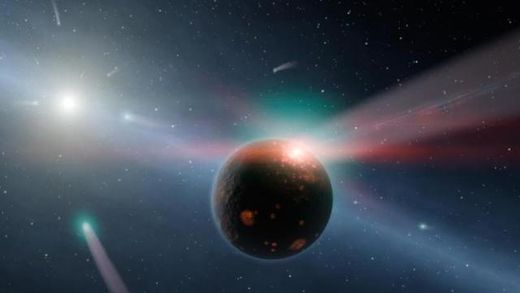
© NASA/JPL-Caltech
The Eta Corvi solar system is like a window into how our own solar system looked billions of years ago. All of Eta Corvi is being bombarded by giant comets - the exact same process that created Earth's oceans.
What's more, observations by NASA's Spitzer telescope show signs of huge dust clouds close to the system's star. The most obvious way to create dust clouds like that is if a huge comet collided with a planet near the star. Analysis of the light coming from the dust suggests it's composed of water ice, organic compounds, and rock, all of which points very strongly to a big comet.
We can't be sure, but it's certainly possible that this comet actually hit a planet located in Eta Corvi's habitable zone. If that's the case, then we're witnessing what is essentially a reenactment of the formation of our planet's oceans. Earth got huge amounts of its water and carbon-based organic compounds during an epoch known as the Late Heavy Bombardment, in which comets from the Kuiper Belt beyond Neptune began hurtling towards the inner solar system due to gravitational disturbances from Jupiter and Saturn.
We probably owe the existence of life as we know it to a bunch of comets, and now the Eta Corvi system is in the middle of the exact same process. The Eta Corvi system even has its very own answer for the Kuiper Belt, as astronomers had previously discovered the existence of a massive ring of cold dust located about 150 astronomical units from the star, meaning the distance is 150 times that between the Sun and Earth.
Lead researcher Carey Lisse explains the potential of studying what's going on in the Eta Corvi system:
"We believe we have direct evidence for an ongoing Late Heavy Bombardment in the nearby star system Eta Corvi, occurring about the same time as in our solar system. We think the Eta Corvi system should be studied in detail to learn more about the rain of impacting comets and other objects that may have started life on our own planet."Because a lot of what's going on in the Eta Corvi system is too dim for our telescopes to see, we can't be sure of everything that's going on there. But it does appear that we're witnessing something very close to what happened in our own solar system more than 3.8 billion years ago, which is an exciting thought. Indeed, as we get better and better at observing alien solar systems, each in different phases of development, we may be essentially able to reconstruct our solar system's entire past and future. Eta Corvi is just one pretty crucial piece of that cosmic reenactment.
Mainstream Science catching up: Most Planets' Oceans are Probably Seeded by Comets
Mike Wall
SPACE.com
Fri, 21 Oct 2011 14:29 CDT
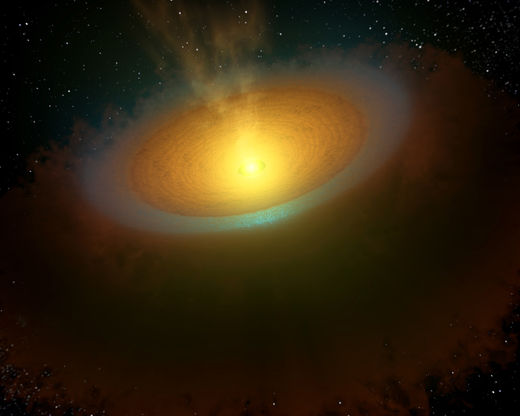
© NASA/JPL-Caltech
Artist's concept illustrating an icy planet-forming disk around the star TW Hydrae, located about 175 light-years away in the constellation Hydra. Astronomers found huge stores of cool water vapor (illustrated in blue) in the frigid outer regions of the star system, where comets will take shape.
A still-forming alien solar system has enough water in its outer reaches to fill Earth's oceans several thousand times over, a new study finds.
The discovery marks the first time astronomers have detected water in a dusty planet-forming disk so far from its central star, in the frigid region where comets are born. Scientists think comet impacts delivered most of Earth's water, and the new study hints that alien planets may commonly acquire oceans in the same way.
"We now know that large amounts of water ice are available in planet-forming disks, ready to be incorporated in comets," said Michiel Hogerheijde, of Leiden Observatory in the Netherlands, the study's lead author. "Ultimately, some of this water may end up on Earth-like planets that form completely dry but this way may end up with life-supporting oceans."
A nearby star
Hogerheijde and his team made the find using the European Space Agency's Herschel Space Observatory. They trained Herschel on the appropriately named young star TW Hydrae, which is located about 175 light-years away in the constellation Hydra (the Sea Serpent).
TW Hydrae is an orange dwarf star, slightly smaller and dimmer than our sun. It's only about 10 million years old, and is still surrounded by a disk of dust and gas that should one day coalesce to form planets, researchers said.
Herschel detected huge amounts of water - thousands of times more water than is found on Earth - in the freezing-cold outer reaches of this disk, far from TW Hydrae itself. The water out there is likely ice coating the innumerable tiny dust grains that swirl around in the disk, researchers said.
Ultraviolet radiation from TW Hydrae knocks some water molecules free from these icy grains, allowing Herschel to spot the light signature from the resulting vapor.
Astronomers have found water vapor in the warmer, interior regions of other planet-forming disks before. So Hogerheijde's team wasn't shocked to find evidence of water farther out.
"We had actually always suspected that this much water was hiding out in the cold reaches of disks like these," Hogerheijde told SPACE.com in an email. Thanks to Herschel, he added, "we can now for the first time detect the water vapor, and infer the presence and size of the hidden ice reservoir."
The team reports its results in the Oct. 21 issue of the journal Science.
Alien comets, alien oceans?
The TW Hydrae find suggests that ice-bearing comets may form commonly around other stars. The icy wanderers might thus have seeded oceans on many alien planets throughout the cosmos over the years, researchers said.
"It does seem likely that life-supporting environments can form easily around other stars, now that we have found sufficient water ice to seed Earth-like planets with oceans," Hogerheijde said.
The discovery could also help astronomers better understand solar system evolution and planet formation in a general sense, he added.
For example, large quantities of ice in a protoplanetary disk could serve as a sort of glue, Hogerheijde said, helping dust grains stick together and grow into planetesimals, the building blocks of planets.
Also, analysis of TW Hydrae's far-flung ice shows that it's significantly different than that found on comets in our solar system. This suggests that comets' ice comes from several different regions in the dusty disk, not just the freezer on its outer edge.
"We actually think that comets in our own solar system contain mixtures of ices from across the solar nebula, hinting at the presence of long-range transportation of material through planet-forming disks," Hogerheijde said. "This is a much more 'dynamic' picture of planet formation than previously imagined."
US: Bright Meteor Lights Up Night Sky From Minnesota to Nebraska
kcautv.com
Fri, 21 Oct 2011 14:49 CDT
Wednesday there were reports from people across the region who saw a bright flash of light in the sky about 3:30 am.
That bright flash was seen as far north as Minnesota and as far south as Lincoln, Nebraska.
Now we've learned it was a meteor streaking through the sky.
A security camera at the Lincoln airport caught the flash in action.
If you'd like your chance to see some meteors streaking across the night sky your best chance is Friday night starting at 10pm until Saturday 3am.
Watch video here.
UFO over Sioux Falls? Experts think it was a meteor
Brenda Wade Schmidt
Argus Leader
Fri, 21 Oct 2011 15:16 CDT
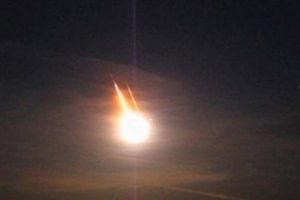
© File Photo
Amie Neustrom doesn't have a good explanation for what she saw in the night sky near her Renner home early Wednesday.
It surprised her and happened so fast that she isn't sure whether it was a meteor or a UFO.
"I really honestly don't know what to think," she said.
It was about 3:30 a.m., and she was on her deck smoking a cigarette when the deck lit up and an orange-and-blue object streaked off, leaving a trail of smoke behind.
"It was quick ...," she said. "I've never seen anything like it. I've seen shooting stars out here. Nothing like this. It was so bright."
Several other Sioux Falls area residents also reported seeing an unusual flash of light in the sky about that time, as well.
At least two people called Metro Communications and five law enforcement officers said they, too, saw the bright light, according to emergency officials. Their locations ranged from Hartford to Brandon and north of Sioux Falls to 57th Street and Western Avenue.
The National Weather Service in Sioux Falls received calls from people near Brandon who saw the unexplained object, said Tim Masters, a technician with the weather service.
But there is an explanation, he said.
"It wasn't a UFO. It was a meteor," he said. "It lit up the sky pretty bright."
There were no reports of an object hitting the ground, he said.
"We just know that it's probably just a little rock that fell through the atmosphere and probably burned up when it fell down," Masters said.
The incident was a random event and not part of a meteor shower, he said.
Neustrom, 38, reported what she saw to Peter Davenport, director of the nonprofit National UFO Reporting Center in eastern Washington state.
People who are unfamiliar with the UFO phenomenon will default to the explanation being a meteor, Davenport said, though the bright light is consistent with a meteor, he said. The only way to tell for sure would be to interview in detail the people who saw it, he said.
"There are many, many events that occur which, when we get into the fine detail ... it seems obviously it could have not been a meteor," Davenport said.
Faulkes Team Images Trojan Jupiter Comet
Adrian West
Universe Today
Fri, 21 Oct 2011 21:54 CDT
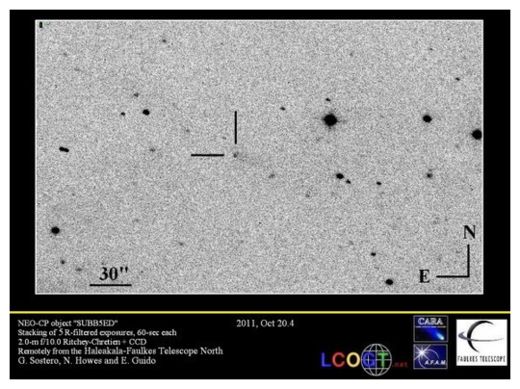
© Universe Today
Jupiter Comet
Based on an observation posted on the Near Earth Object confirmation page from an image taken by A. D. Grauer using the mount Lemmon observatory, Faulkes telescope team members Nick Howes, Giovanni Sostero and Ernesto Guido along with University of Glamorgan student Antos Kasprzyk and amateur astronomer Iain Melville, imaged what is potentially some of the first direct evidence for a Trojan Jupiter Comet.
Comet P/2010 TO20 (LINEAR-GRAUER) was immediately recognised by the team from looking at the orbit to be a highly unusual object, but it was only when the images came through from the Faulkes observations that the true nature of the object became clear.
The observations showed a distinct cometary appearance, with a sharp central condensation, compact coma and a wide, fan-shaped tail.
This is no ordinary comet, and supports the theory and initial spectral observation work by a team using the keck telescope in Hawaii. Closer analysis of their object (part of a binary known as the Patroclus pair) showed that it was made of water ice and a thin layer of dust, but at the time of writing, no direct images of a Jupiter Trojan showing evidence of a coma and tail had been taken.
The Faulkes teams above image, combined with the original observations by Grauer clearly show a cometary object, thus confirming the Keck team's hypothesis.
According to the CBET released today "After two nights of observations of Grauer's comet had been received at the Minor Planet Center.
Spahr realized that this object was identical with an object discovered a year ago by the LINEAR project (discovery observation tabulated below; cf. MPS 351583) that appeared to be a Jupiter Trojan minor planet."
The observations have now proved it is not a minor planet, but a comet.
This discovery could provide new clues about the evolution of the Solar System, suggesting that the Gas Giants formed closer to the Sun and as they moved further away, they caused massive perturbations with Kuiper Belt objects, trapping some in their own orbits.
Nick Howes on the Faulkes team said "When we first saw the preliminary orbit, we knew it was a quite remarkable object" Howes also added "To have a University Student also involved is terrific for the degree program at Glamorgan and also for the Faulkes project. We'd like to extend our congratulations to Al Grauer" for his detection of this groundbreaking new comet" and we're immensely proud to be part of the CBET released by the IAU confirming its nature.
References:
Space Is Ace
Spacedaily.com
Remanzacco Observatory
UK: Meteorite crashes into sea
Lynn Cox
KentOnline
Sat, 22 Oct 2011 08:57 CDT
A meteorite falling into the sea sparked a search and rescue mission last night after two people reported they saw a plane crash into the water off the coast of Whitstable.
Kent Fire and Rescue Service were called out after a pilot and another person both reported they saw what the thought was an aircraft crashing into the sea.
However, after firefighters from Whitstable and nearby Herne Bay scoured the area, no trace of the aircraft could be found.
Air traffic controllers, reported they didn't have any planes missing, so eventually the search was called off, and put down to a meteorite falling to Earth.
Hundreds of meteorites are expected to streak across the sky this weekend as the Earth passes through a cloud of dust left by behind by a comet called Giacobini-Zinner.
A spokesman for Kent Fire and Rescue Service said: "Two independent calls came in reporting a plane had crashed off the coast.
"Even a pilot who was looking out of his window reported a plane was in distress and had gone into the sea.
"Fishermen in the area also reported seeing something, but in the end nothing was found and it was put down to a meteorite falling to Earth."
SOTT archive
Comet Elenin cloud corpse spotted in space
Space Weather
Mon, 24 Oct 2011 11:45 CDT
>
"Doomsday Comet" Elenin was briefly famous for inaccurate predictions that it might hit Earth. Instead it disintegrated as it approached the sun last month. (Doomsday canceled.) Over the weekend, Italian astronomer Rolando Ligustri spotted the comet's remains. It's the elongated cloud in this Oct. 22nd photo of the star field where Elenin would have appeared if it were still intact:

© Rolando Ligustri
Another team of astronomers--Ernesto Guido, Giovanni Sostero and Nick Howes--spotted the cloud on the same night. At first they were skeptical. "The cloud was extremely faint and diffuse," says Guido. "We wondered if it might be scattered moonlight or some other transient artifact." But when the team looked again on Oct. 23, the cloud was still there. A two-night blink animation shows that the cloud is moving just as the original comet would have. Note: Some readers have noticed a fast-moving streak to the to the lower right of the debris cloud. That is an unrelated asteroid, 2000 OJ8 (magnitude 14), which happened to be in the field of view at the same time as the cloud of Elenin.
More information about this discovery and continued tracking of the "comet corpse" may be found at the Remanzacco Observatory Astronomy Blog.
Read on SOTT.net
Video Captures Draconid Meteor
redOrbit
Tue, 25 Oct 2011 00:39 CDT
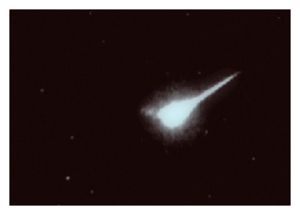
© redOrbit
This video catches the moment when a Draconid meteor exploded in Earth's atmosphere earlier this month. The dramatic footage comes from a campaign to observe this important meteor shower using aircraft to beat the clouds.
On the evening of Saturday 8 October, Earth plunged through a stream of dust and rocks that had been expelled into space by the comet Giacobini - Zinner. The resultant meteor shower lit the skies over Europe with shooting stars.
The display radiates from the constellation of Draco, The Dragon, giving the name of "Draconids" to this shower which occurs at the same time every year as the Earth passes through the debris trail. In 2011, however, there was a difference. Astronomers had predicted an unusually high numbers of meteors as Earth was due to encounter particularly dense patches of the cometary detritus.
Detlef Koschny, leader of the Meteor Research Group at ESA, led the Agency's involvement in a project to find out if the prediction was right.
With cameras and other equipment packed into two Falcon-20 research planes, Detlef's colleagues took to the skies over Europe to rise above the clouds and watch for meteors.
"The Draconids peaked as predicted. A small peak at 17:30 GMT and then a larger one at 20:05 GMT," says Detlef.
The two planes flew on parallel tracks roughly 100 km apart as the researchers pointed their cameras at the same volume of Earth's atmosphere. The data they collected will allow each meteor to be triangulated, to determine its altitude and trajectory. Typically, meteors burn up between 80-120 km above the ground, well above the cruising altitude of an airliner. This will give updated information about the meteor stream itself, and the way the comet ejected the material.
It has been calculated that most of the meteors hitting Earth that night were ejected by comet Giacobini - Zinner in 1900 and have been circling the Sun ever since.
The team also recorded the spectrum of at least one meteor, which will reveal its chemical composition.
The Draconid meteor stream is important to understand because, like other streams, it can pose a danger to orbiting spacecraft. The tiny impacts can damage solar panels or sensitive optics.
The Draconids tend to be overlooked in favor of more visible displays such as the Leonids in November. This could be a mistake according to Detlef: "The Draconids move more slowly relative to Earth, so we don't see all of the smaller ones burning up. But they are still there, probably as many in number as the Leonids, only it's harder to find them."
Watch the Video.
Discovery: Cosmic Dust Contains Organic Matter from Stars
Denise Chow
Space.com
Thu, 27 Oct 2011 01:32 CDT
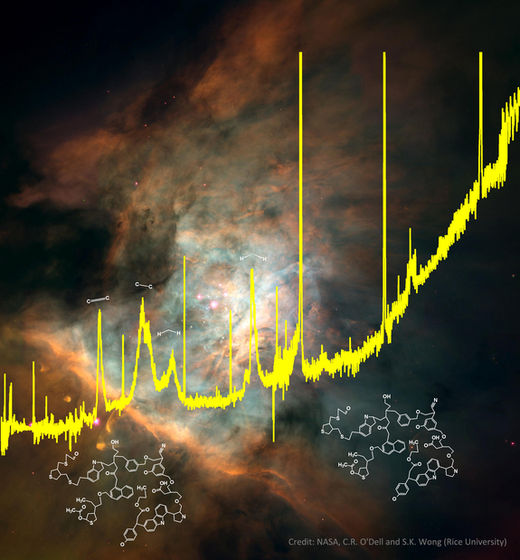
© NASA, C.R. O'Dell, S.K. Wong (Rice University)
A spectrum from the European Space Agency's Infrared Space Observator superimposed on an image of the Orion nebula, where these complex organics are found.
A new look at the interstellar dust permeating the universe has revealed hints of organic matter that could be created naturally by stars, scientists say.
Researchers at the University of Hong Kong observed stars at different evolutionary phases and found that they are able to produce complex organic compounds and eject them into space, filling the regions between stars. The compounds are so complex that their chemical structures resemble the makeup of coal and petroleum, the study's lead author Sun Kwok, of the University of Hong Kong, said.
Such chemical complexity was thought to arise only from living organisms, but the results of the new study show that these organic compounds can be created in space even when no life forms are present. In fact, such complex organics could be produced naturally by stars, and at an extremely rapid pace.
"What impressed me most is that complex organics are easily formed by stars, they are everywhere in our own galaxy and in other galaxies," Kwok told SPACE.com in an email interview. "Nature is much more clever than we had imagined."
The findings of the new study were published online today (Oct. 26) by the journal Nature.
Scanning the cosmos in infrared
Kwok and his colleague Yong Zhang, also of the University of Hong Kong, studied a set of well-known but mysterious infrared emissions found in stars, interstellar space and galaxies. These phenomena, which are collectively called Unidentified Infrared Emission (UIE) features, have been known for 30 years, but the exact source of the emissions has not been pinned down, and remains a broad assumption.
"In the astronomy community, it has been commonly assumed that the UIE features are emitted by [polycyclic aromatic hydrocarbon, or PAH] molecules, which are simple, purely aromatic, molecules made of carbon and hydrogen," Kwok said. "Our paper suggests that the PAH hypothesis is not correct."
Kwok and Zhang analyzed data from the European Space Agency's Infrared Space Observatory and NASA's Spitzer Space Telescope to show that the Unidentified Infrared Emission features are not emitted by PAH molecules because the emissions have chemical structures that are far more complex.
"I have been suspecting this for many years," Kwok said. "Now we think we have the evidence."
The researchers observed stars at different phases of stellar evolution - first low- to medium-mass stars, then stars in the protoplanetary nebula phase, which is a short-lived episode during a star's rapid evolution, and finally stars in the planetary nebula phase, which is characterized by an expanding shell of ionized gas that is ejected by certain types of stars late in their life.
Kwok and his colleague found that characteristics of the Unidentified Infrared Emission features could not be detected in low- to medium-mass stars. But, the astronomers found that the emissions began to appear in stars in the protoplanetary nebula stage and grew stronger as the stars matured into the planetary nebula phase.
"We therefore know that these organics are being made in the circumstellar stellar environment," Kwok said.
More surprises
Another surprising thing they found was just how quickly stars were generating complex organic compounds and ejecting the dusty material into their surrounding environment.
"Since we know their dynamical and evolutionary ages of these objects (dynamical age is how fast the nebula will disperse, and evolutionary age is how fast the star is evolving), we can put constraints on the chemical time scales," Kwok said. "Since the dynamical/evolution ages are of the order of thousands of years, the appearance of the spectral features suggests that the organic compounds are made on time scales shorter than thousands of years."
The researchers also studied emissions from exploding stars and found that these dynamic cosmic events produced dust even more rapidly.
"Their spectra changed from a pure gas spectrum to a dust spectrum on a matter of days or weeks," Kwok said. "The sudden appearance of the features suggests that organic dust can be made extremely quickly."
But, the findings throw a wrench into existing theories that posit that stars cannot produce such complex organic compounds in the near-vacuum environment of space.
"Theoretically, it is very difficult to understand because of the very low density of the circumstellar environment," Kwok said. "But, observationally, there is no doubt as we see these spectral features appearing and changing on very short time scales. This means that these organic solids are condensing directly from the gas phase."
Star dust and the early solar system
The scientists also found that the chemical structure of organic star dust is similar to complex organics found in meteorites. Since meteorites originate from space rocks that are remnants of the early solar system, the results of the study suggest that stars could have enriched the early solar system with organic compounds, Kwok said.
"It is quite possible that the organics in meteorites are remnants of star dust in the solar nebula," he explained. "The star dust [was] ejected by nearby planetary nebula[s] and survived the journey across the galaxy."
Early in the Earth's formation history, the planet was pummeled in a shower of meteorites and comets during a period known as the Late Heavy Bombardment. Since the organic compounds in meteorites are similar to what was found in stellar dust, the results of this new study show that the barrage of meteorites that fell to Earth during the Late Heavy Bombardment could have carried organic star dust.
While it may be too soon to determine whether these organic compounds played a role in kick-starting the development of life on Earth, it certainly is a possibility, Kwok said.
"If this is the case, life on Earth may have had an easier time getting started as these organics can serve as basic ingredients for life," he said.
Further research in this area will be necessary, and Kwok intends to continue analyzing additional infrared observations to better pin down the chemical structure of organic star dust. He is also interested in studying more about how and why stars are able to produce complex organics as quickly as they seem to.
"Coal and kerogen are products of life and it took a long time for them to form," Kwok said. "How do stars make such complicated organics under seemingly unfavorable conditions and [do] it so rapidly?"
US, California: Mystery Lights Interrupt News 8 Live Shot
Fireball Recorded Entering Atmosphere over Japan on October 19
Sheilaaliens
YouTube
Sun, 30 Oct 2011 11:29 CDT
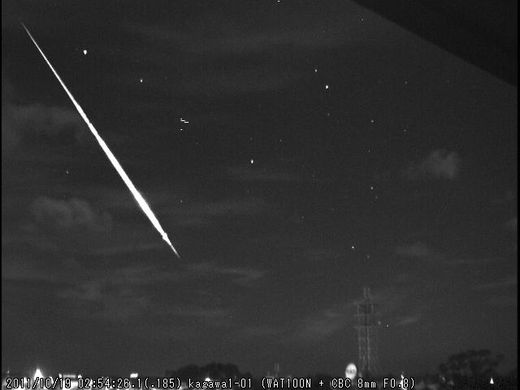 Source
Source
While you're there, check out the "etc." section for what they have captured... Very interesting!
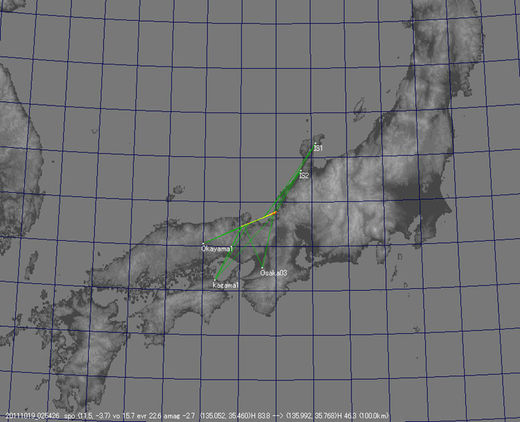
The various vantage points of different witnesses place the fireball's trajectory in the yellow line, running Southwest to Northeast (left to right).
Comets - Not What We Expected
Michael Suede
YouTube
Sun, 30 Oct 2011 03:28 CDT
This video highlights recent discoveries about comets that shatter existing theories in favour of the Electric Comet Theory.
Supporting documentation and links to all the NASA quotes, web sites, and papers used in the video can be found here.
Part 1
Part 2
Part 3
Part 4
Part 5
Part 6
The narrator's website
Sun Diving Comet, October 30th
Space Weather
Mon, 31 Oct 2011 01:28 CDT
A small comet dove into the sun during the late hours of Oct. 30th. Blasted by intense solar heat, the 'dirty snowball' disintegrated in plain view of the Solar and Heliospheric Observatory (SOHO). Watch the movie below and note how the comet shrinks to a pinprick just before it vanishes.
Watch video on YouTube
Asteroid's Near-Miss Reminder Of Doomsday Threat
The Indy Channel
Mon, 31 Oct 2011 13:58 CDT
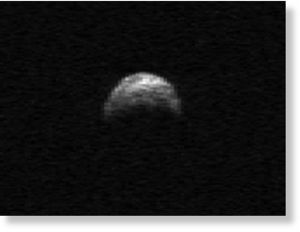
© NASA - YU55 will pass near Earth on Nov. 8, scientists say
Purdue Scientist Estimates Impact Of Large Object.
Though there's no threat that it will strike Earth, a large asteroid that will pass close to the planet on Nov. 8 would have had a devastating effect if it were to hit the planet, experts said.
The aircraft carrier-sized asteroid, known as YU55, was discovered in 2005. At its closest approach, scientists project it will be 201,000 from Earth.
The near-miss is a reminder of how fragile the planet is.
Jay Melosh, a professor of earth and atmospheric sciences at Purdue University, said the impact of an object of similar size would be catastrophic, producing an earthquake of magnitude 7.0, prospects of a 70-foot tsunami and worse.
"What is unique about this asteroid flyby is that we were aware of it well in advance," Melosh said. "Before about 1980 we wouldn't know about an asteroid of this size until it was already making a close pass, but now it is unlikely that such an asteroid will approach the Earth without our knowledge."
NASA and Spacewatch monitor near-Earth objects that are 0.6 mile or larger in diameter. The close approach of the asteroid has been expected since 2005, when it was discovered.
Scientists at Purdue put together a calculator, called Impact Earth to estimate the impact of an object striking Earth, approximating the type of damage it could cause.
The calculator estimated that if YU55 hit Earth, a 1,700-foot-deep crater four miles in diameter would be created and that humans would endure extensive first-degree burns 60 miles away from the point of impact.
An object the size of YU55 would destroy a large city if it took a direct hit.
NASA said the last time an asteroid of a similar size came close to hitting Earth was in 1976, and that a known large asteroid will be near the planet in 2028.
Earth is scarred by craters scientists believe were created by similar-sized objects, including craters in Alabama and Wisconsin, Melosh said.
"Impacts from asteroids of this size are very rare," he said. "They occur about once every 100,000 years, so the chances of an actual collision with an asteroid like YU55 is about 1 percent in the next thousand years."
Scientists believe that an asteroid that is about a third of a mile wide has a small chance of hitting Earth in 2036.
Read also: Large Asteroid to Pass by Earth Nov. 8, 2011 But What If It Didn't?
'Continent Killer' Asteroid On Possible Collision Course With Earth
redOrbit
Mon, 31 Oct 2011 14:34 CDT
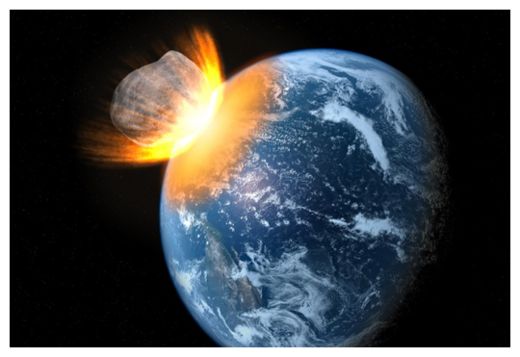
© redOrbit
On the heels of the return to Earth of a pair of satellites - NASA's Upper Atmosphere Research Satellite (UARS) and the German-built Röntgensatellit (ROSAT) - over the past two months comes a report of another object set to collide with our planet.
Only this one is a 20 million ton asteroid that is currently heading towards us at 23,000 miles per hour, and could collide with our planet in approximately 25 years, Alex Hannaford of the Telegraph wrote on Sunday. The asteroid in question, Apophis, is more than 800 feet wide, comprised of a mixture of rock, ice, and dust, and has been dubbed "the continent killer."
"There are two scenarios," Hannaford writes. "The first, and thankfully most likely, is that Apophis will fly by in April 2029, the year it is due to make its first 'close approach', and that's the last we'll see or hear of it. The second is that during that approach, it'll pass through what scientists refer to as a 'keyhole' - a small area of space that can alter the asteroid's course due to Earth's gravity."
"If this happens, it'll be on a massive collision course with us seven years later, likely to be April 13, 2036 - Easter Sunday," the Telegraph reported added, noting that experts with NASA's Jet Propulsion Laboratory in California claim that it is "too far away" to predict which of the two possibilities is most likely, but that they should be able to know more in the near future.
"We don't know precisely where Apophis is headed but we will soon, when it becomes observable again, probably in 2012 or 2013," Paul Chodas of the U.S. space agency's Near Earth Object (NEO) said. "Once we get radar on it we will be able to nail down its orbit and we will know the chances of it going through the keyhole and hitting in 2036. By that time, it could be a four in a million chance, and that could very well go down to zero."
That might not be the end of it, though, as Chodas told Hannaford that the asteroid could find another one of those "keyholes" - small regions of space that can alter the course of a passing asteroid, due to a planet's gravity - meaning that even if it misses the planet the first time, it could theoretically return and collide with the Earth's surface later on.

1 comment:
I love meteorites, when I was a kid I even tried to fake one so I could get the attention of my brothers, ha ha! Well, it didn't work because my mom found out I was heating up a piece of asphalt in the microwave. So, I was never able to fake it. But it was a fun idea, I had to give it a try, would have been a good prank for kids.
Post a Comment